
8/29/2023
SH 2-129 is a relatively faint emission nebula in Cepheus. Sometimes calledo as the "Flying Bat" nebula, this region is characterized by Hydrogen emission. Inside it we found the recent discovery made in 2011 by Nicolas Outters, called the "Squid Nebula" due to its shape, but more officially called Ou4. This region is characterized by a very faint OIII emission and its bipolar shape reminds of a planetary nebula. Wikipedia
The remarkable nebula's bipolar shape and emission are consistent with it being a planetary nebula, the gaseous shroud of a dying sun-like star, but its actual distance and origin are unknown. A new investigation suggests Ou4 really lies within the emission region SH2-129 some 2,300 light-years away. Consistent with that scenario, the cosmic squid would represent a spectacular outflow of material driven by a triple system of hot, massive stars, cataloged as HR8119, seen near the center of the nebula. If so, this truly giant squid nebula would physically be nearly 50 light-years across. Robert Nemiroff (MTU) & Jerry Bonnell (UMCP)
Imaging Data:
Provo, Utah
Bortle 5 sky
Date August 27&28 ,2023
Image: SH 2-129
Size: 2.3 deg
Magnitude: N/A
Exposure= 240 seconds and 206 lights for a total of 13 hours and 44 minutes
Gain=100
Binning = 1×1
Camera Temperature= 0 deg C
Filter= IDAS-NBZ Narrowband Filter
Camera: ASI2600MC PRO in Hyperstar configuration.
Telescope: Celestron 1100 Edge HD
Mount : 10MICRON GM1000HPS
Processed with DSS, PI and PS
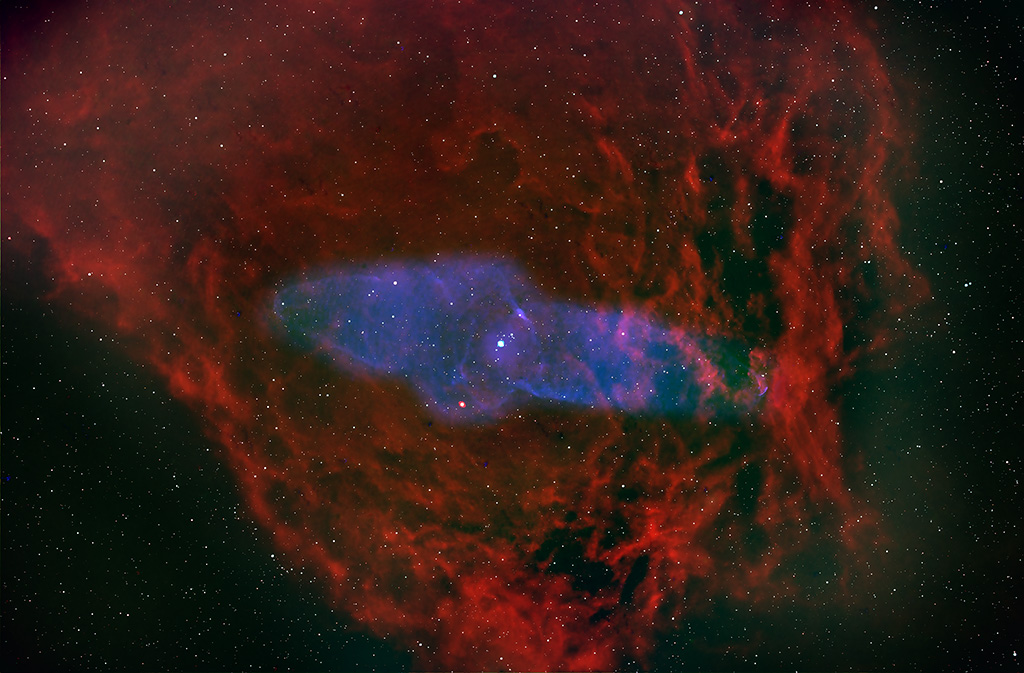
8/17/2023
This is the Cygnus Wall; it is part of the North American Nebula and is referred to as NGC 7000.
I imaged this over the nights of 12,13 and 16th of August 2023. The wall spans about 20 light years and is approximately 1500 light years from Earth. The wall exhibits the most concentrated star formations in the nebula.
Imaging Data:
Provo, Utah
Bortle 5 sky
Date: 8/12,13,16/2023
Image: Cygnus Wall
Exposure= 180 seconds x 500 for a total of 18h 23m
Binning = 1×1
Camera Temperature= 0 deg C
Camera Gain= 100
Filter= IDAS-NBZ Narrowband Filter
Camera: ASI2600MC PRO in Hyperstar IV configuration.
Telescope: Celestron 1100 Edge HD
Mount: 10Micron GM1000HPS
Processed with DSS, PI and PS
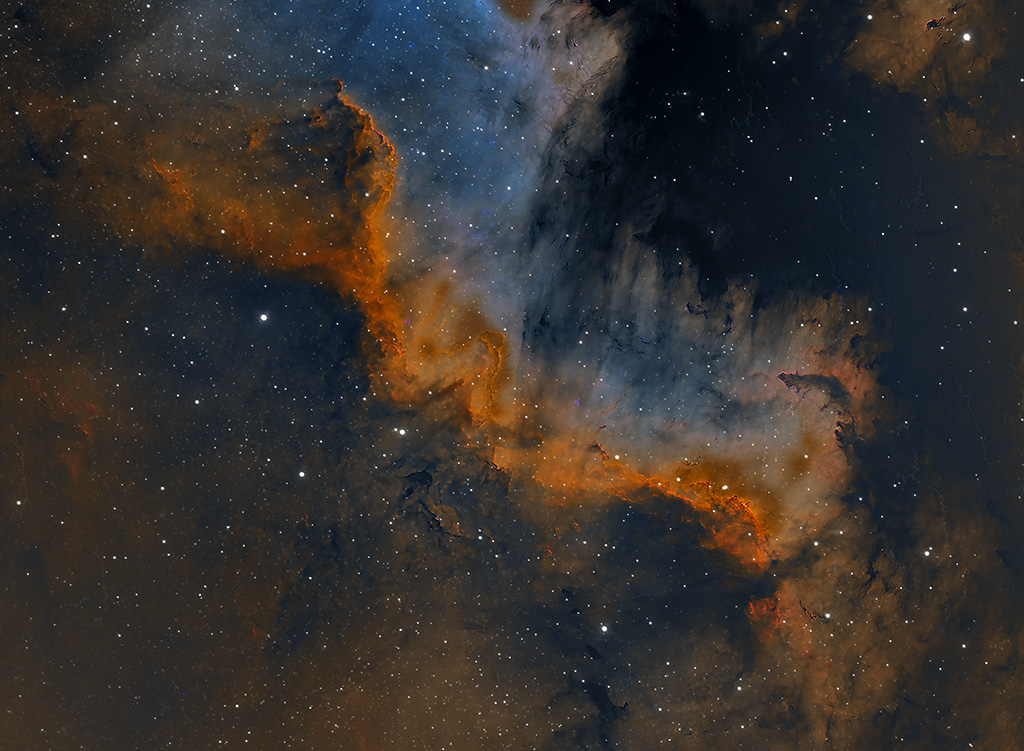
IC 410 is a faint and dusty emission nebula of more than 100 light-years across, located near the Flaming Star Nebula (IC 405) in a large star forming (HII) region about 12,000 light-years away from Earth in the northern constellation of Auriga.
The cloud of glowing gas is sculpted by stellar winds and radiation from the embedded open star cluster catalogued as NGC 1893, which is just about 4 million years old. The massive, hot stars of this cluster are all very young, having only been recently formed from IC 410. The bright stars of this cluster are seen just below the prominent dark dust cloud near picture center.
Notable are two streamers of material, known as the “Tadpoles of IC 410”. These tadpoles, which consist of denser, cooler gas and dust, are approximately 10 light-years long and potentially sites of ongoing star formation.
Form given by the winds and radiation of the cluster’s stars, the tadpoles are pointing their tails outwards, away from the nebula’s central regions. Because of these tadpoles, IC 410 is sometimes nicknamed the Tadpoles Nebula. “ANNESASTRONOMYNEWS.COM”
Imaging Data:
Provo, Utah
Bortle 5 sky
Date : Dec 3,4,5 2021
Exposure : 120s x 167 for 8h 21m from a total stack of 20.5 hours
Darks & flats were included, stacked in DSS and post processed using
PI and PS
Gain=125
Binning = 1×1
Camera Temperature= -10 deg C
Filter= IDAS NBZ Narrow band filter
Camera: ASI294MC PRO in Hyperstar configuration.
Telescope: Celestron 1100 Edge HD
Mount: 10Micron GM1000HPS
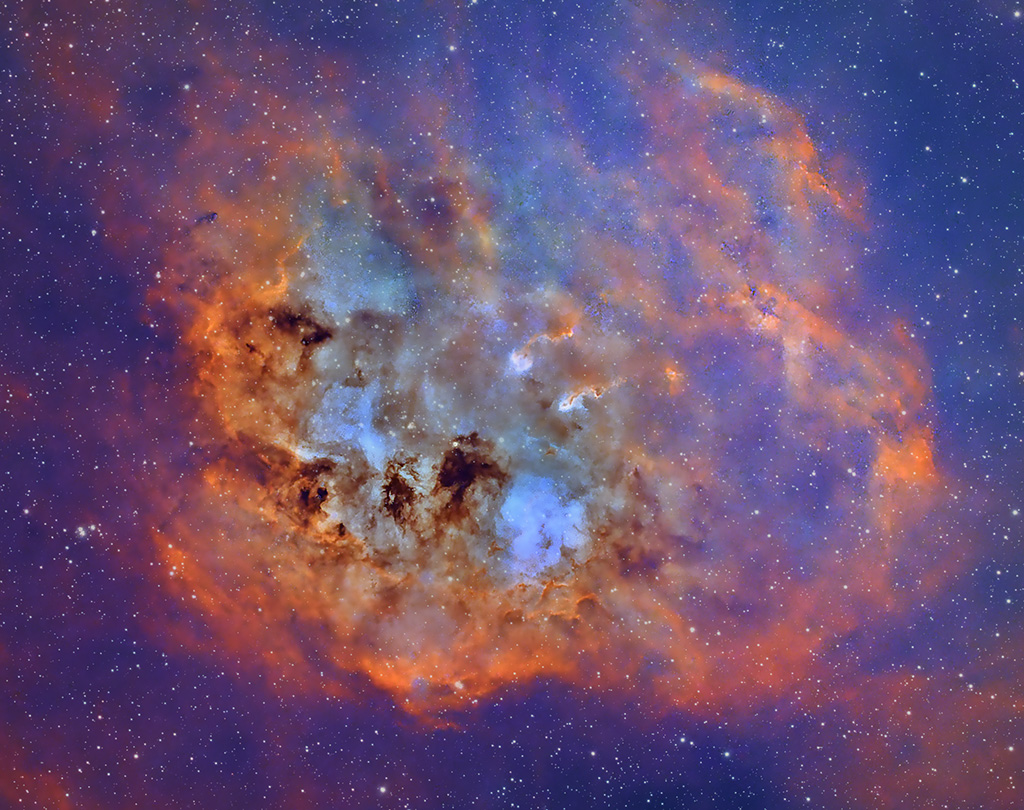
The Crescent Nebula and the Soap Bubble Nebula
The Crescent Nebula (also known as NGC 6888, Caldwell 27, Sharpless 105) is an emission nebula in the constellation Cygnus, about 5000 light-years away from Earth. It was discovered by William Herschel in 1792. It is formed by the fast stellar wind from the Wolf-Rayet star WR 136 (HD 192163) colliding with and energizing the slower moving wind ejected by the star when it became a red giant around 250,000 to 400,000 years ago. The result of the collision is a shell and two shock waves, one moving outward and one moving inward. The inward moving shock wave heats the stellar wind to X-ray-emitting temperatures.
It is a rather faint object located about 2 degrees SW of Sadr. For most telescopes it requires a UHC or OIII filter to see. Under favorable circumstances a telescope as small as 8 cm (with filter) can see its nebulosity. Larger telescopes (20 cm or more) reveal the crescent or a Euro sign shape which makes some to call it the "Euro sign nebula". (Wikipedia)
The Soap Bubble Nebula (also known as PN G075.5+01.7) is a planetary nebula in the constellation Cygnus, near the Crescent Nebula (NGC 6888). It was discovered by amateur astronomer Dave Jurasevich using an Astro-Physics 160 mm refractor telescope with which he imaged the nebula on June 19, 2007 and on July 6, 2008. The nebula was later independently noted and reported to the International Astronomical Union by Keith B. Quattrocchi and Mel Helm who imaged PN G75.5+1.7 on July 17, 2008. The nebula measures 260″ in angular diameter with a central star that has a J band magnitude of 19.45. Wikipedia
Imaging Data:
Provo, Utah
Bortle 5 sky
Date: 6/25/2023, 7/4,5,6,7/2023
Exposure= 180 seconds x 378 for 18h 54m
Binning = 1×1
Camera Temperature= 0 deg C
Camera Gain= 100
Filter= IDAS-NBZ Narrowband Filter
Camera: ASI2600MC PRO in Hyperstar IV configuration.
Telescope: Celestron 1100 Edge HD
Mount: 10Micron GM1000HPS
Processed with DSS, PI and PS
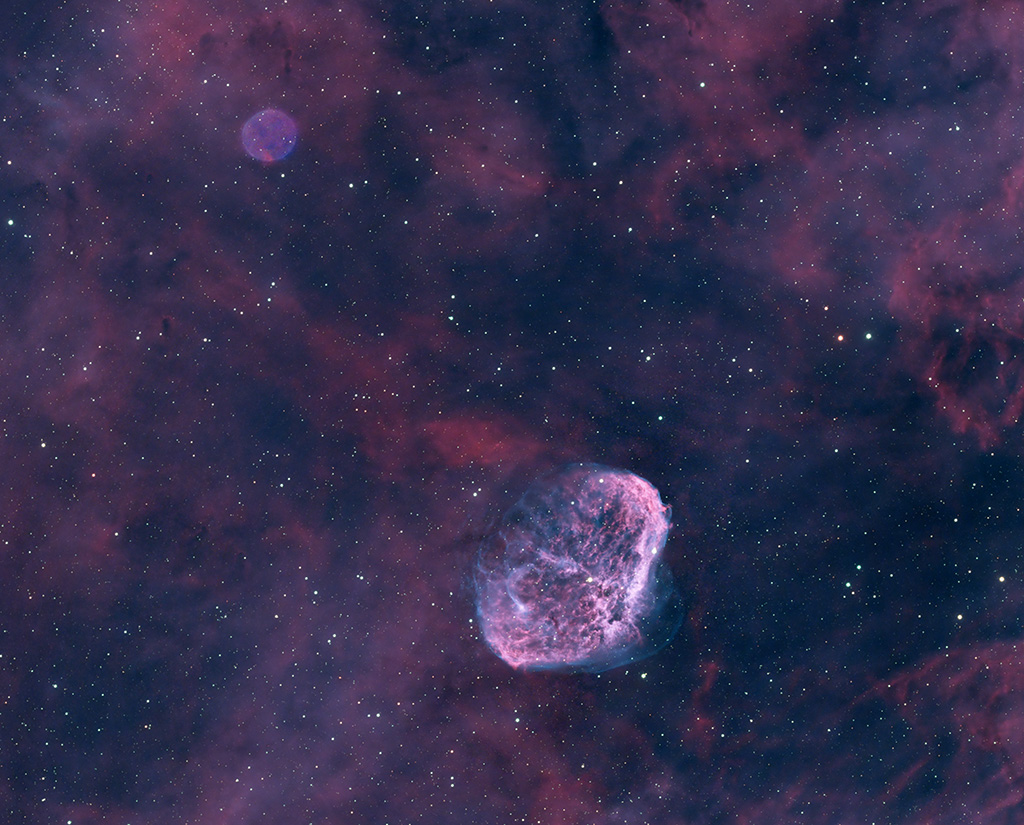
The Dumbbell Nebula (also known as Apple Core Nebula, Messier 27, or NGC 6853) is a planetary nebula in the constellation Vulpecula, at a distance of about 1227 light-years. This object was the first planetary nebula to be discovered; by Charles Messier in 1764. At its brightness of visual magnitude 7.5 and its diameter of about 8 arcminutes, it is easily visible in binoculars, and a popular observing target in amateur telescopes.
Imaging Data:
Date: 8/19/19 Redone 9/22/2023
Exposure= 30s x 420 of which 326 were used for 2h 43m
Binning = 1×1
Gain = 120
Camera Temperature= 0 deg C
Filter= STC Astro Duo-Narrowband Filter
Camera = ASI294MC PRO in Hyperstar position

The Triangulum Galaxy (Messier 33) is a spiral galaxy 2.73 million light-years (ly) from Earth in the constellation Triangulum. It is catalogued as Messier 33 or NGC 598. The Triangulum Galaxy is the third-largest member of the Local Group of galaxies, behind the Milky Way and the Andromeda Galaxy. It is one of the most distant permanent objects that can be viewed with the naked eye.
The galaxy is the smallest spiral galaxy in the Local Group and it is believed to be a satellite of the Andromeda Galaxy due to their interactions, velocities, and proximity to one another in the night sky. It also has an H II nucleus. (Wikipedia)
IMAGING DATA
Provo, Utah
Bortle 5 sky
Date: 10/16/2023
Image: M33
Camera: ZWO ASI2600 MC Pro in Hyperstar Position
Filter: STC Astro Duo-Narrowband
Temperature: -5 deg C
Gain: 100
Binning: 1×1
Exposure: 180 seconds
# of Lights: 134 for 6 hours 42 minutes were used.
Telescope: Celestron 1100 Edge HD
Hyperstar IV Camera mount
Mount: 10Micron GM1000HPS
Pier: Steel pier on 600 lb concrete block
Observatory: NexDome “Y Mountain Observatory”
Software used
Deep Sky Stacker, Pixinsight, Photoshop
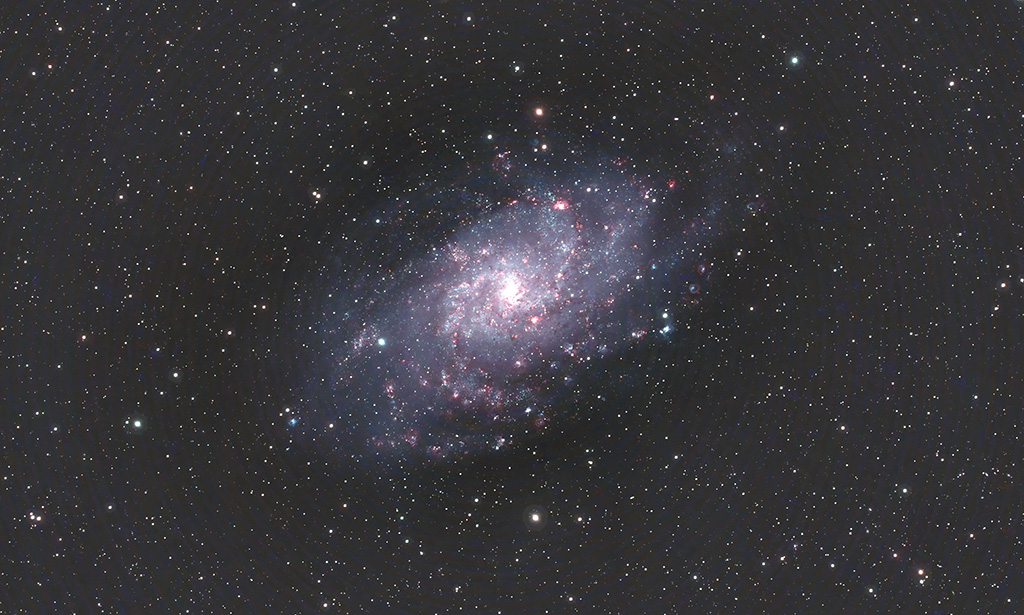
The Rosette Nebula (also known as Caldwell 49) is a large spherical H II region (circular in appearance) located near one end of a giant molecular cloud in the Monoceros region of the Milky Way Galaxy. The open cluster NGC 2244 (Caldwell 50) is closely associated with the nebulosity, the stars of the cluster having been formed from the nebula's matter.
The complex has the following NGC designations:
NGC 2237 – Part of the nebulous region (Also used to denote whole nebula)
NGC 2238 – Part of the nebulous region
NGC 2239 – Part of the nebulous region (Discovered by John Herschel)
NGC 2244 – The open cluster within the nebula (Discovered by John Flamsteed in 1690)
NGC 2246 – Part of the nebulous region
The cluster and nebula lie at a distance of some 5,000 light-years from Earth and measure roughly 130 light years in diameter. The radiation from the young stars excites the atoms in the nebula, causing them to emit radiation themselves producing the emission nebula we see. The mass of the nebula is estimated to be around 10,000 solar masses.
A survey of the nebula with the Chandra X-ray Observatory has revealed the presence of numerous new-born stars inside optical Rosette Nebula and studded within a dense molecular cloud. Altogether, approximately 2500 young stars lie in this star-forming complex, including the massive O-type stars HD 46223 and HD 46150, which are primarily responsible for blowing the ionized bubble. Most of the ongoing star-formation activity is occurring in the dense molecular cloud to the south east of the bubble.
A diffuse X-ray glow is also seen between the stars in the bubble, which has been attributed to a super-hot plasma with temperatures ranging from 1 to 10 million K. This is significantly hotter than the 10,000 K plasmas seen in HII regions, and is likely attributed to the shock-heated winds from the massive O-type stars.
On April 16, 2019 the Oklahoma Legislature passed HB1292 making the Rosette Nebula as the official state astronomical object. Oklahoma Governor Kevin Stitt signed it into law April 22, 2019.
IMAGING DATA
Date (Reprocessed on 9/14/23)
Imaging Dates 2/14/21, 3/1/21, 2/7/22, 3/1/22, 2/3/23
Exposure 60,180,300 sec
No. of lights 157 for 9 hours and 28 minutes
Gain 100
Binning 1×1
Camera ZWO AMI2600MC Pro using Hyperstar IV
Filter STC Astro Duo-Narrowband
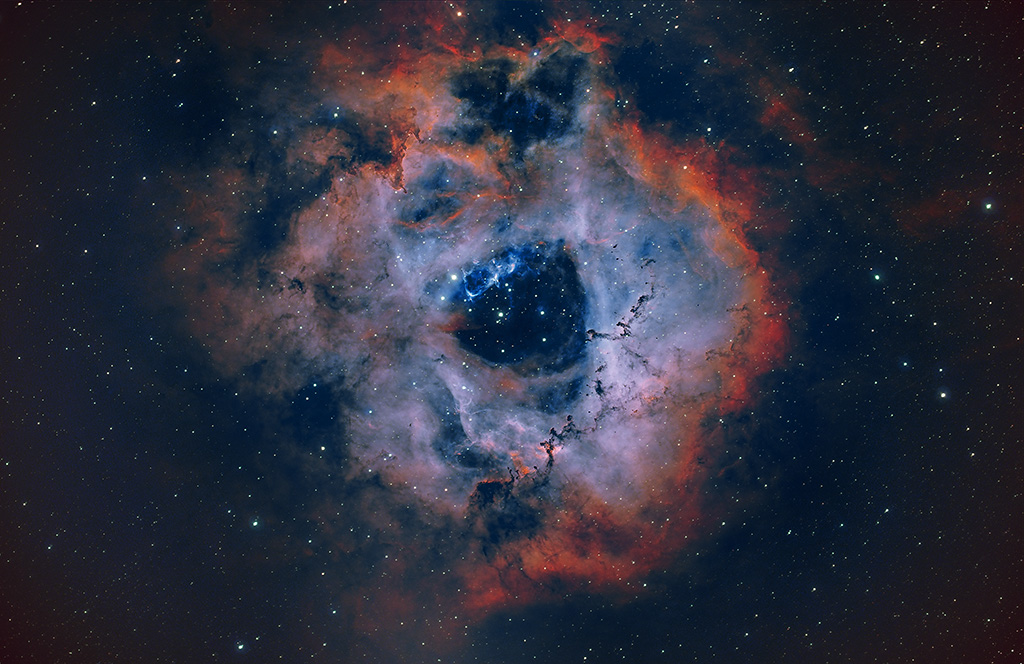
2/21/2022
IC 405 (also known as the Flaming Star Nebula, SH 2-229, or Caldwell 31) is an emission and reflection nebula in the constellation Auriga, surrounding the bluish star AE Aurigae. It shines at magnitude +6.0. Its celestial coordinates are RA 05h 16.2m dec +34° 28′. It surrounds the irregular variable star AE Aurigae and is located near the emission nebula IC 410, the open clusters M38 and M36, and the K-class star Iota Aurigae. The nebula measures approximately 37.0' x 19.0', and lies about 1,500 light-years away from Earth. The nebula is about 5 light-years across.
IMAGING DETAILS:
Taken on 2/19/22
Exp=300 sec x 53 of which 35 were used for 1 h 45 m
Bin = 1×1
Temp=-10 C
Gain=100
Telescope Celestron 1100 Edge HD
Camera ZWO ASI2600MC-PRO with Hyperstar V
Filter: IADS_NBS Narrow Band
Mount 10Micron GM1000HPS on pier
Processed using Images Plus and PhotoShop
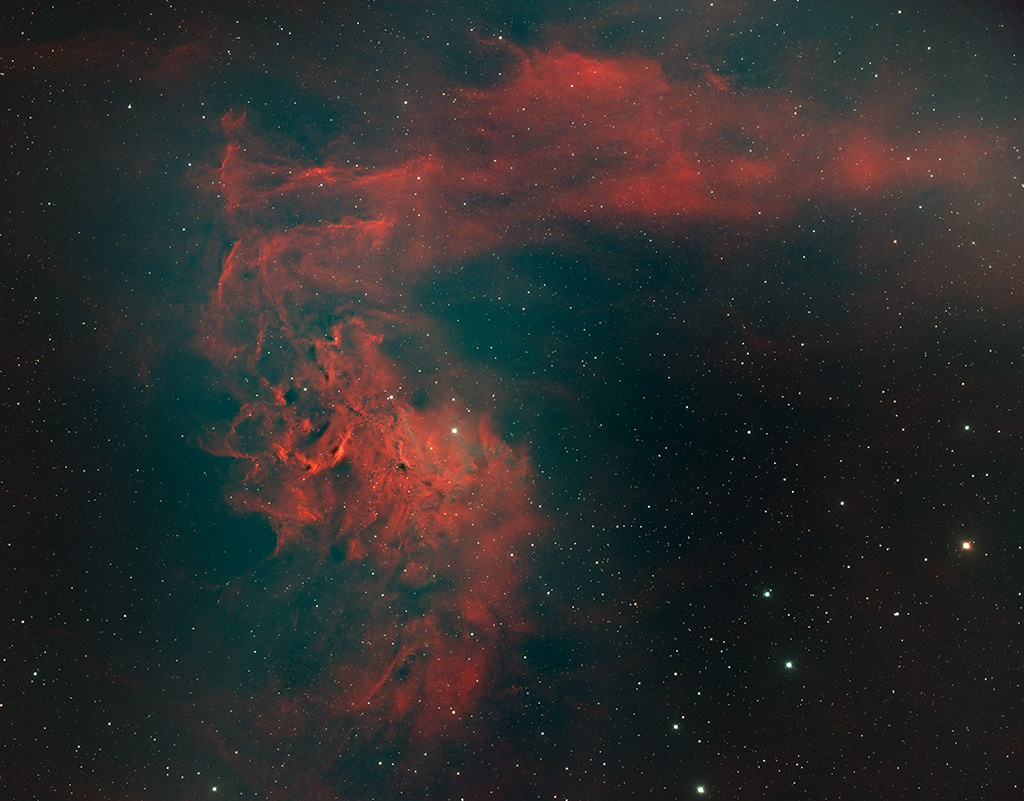
This is a reprocess of images that I took on Jan 7,2019. I reprocessed the data using Images Plus, PixInsight, and PhotoShop.
The Orion Nebula (also known as Messier 42, M42, or NGC 1976) is a diffuse nebula situated in the Milky Way, being south of Orion's Belt in the constellation of Orion. It is one of the brightest nebulae, and is visible to the naked eye in the night sky. M42 is located at a distance of 1,344 ± 20 light years and is the closest region of massive star formation to Earth. The M42 nebula is estimated to be 24 light years across. It has a mass of about 2,000 times that of the Sun. Older texts frequently refer to the Orion Nebula as the Great Nebula in Orion or the Great Orion Nebula. (Wikipedia)
Imaging Data
Image M42
Date 1/7/19
Exposure 120s
Number of Lights 30
Darks Y
Flats Y
Gain 120
Binning 1X1
Imaging Software Sequence Generator Pro
Camera ZWO ASI294MC Pro
Cooling Temp Deg C -10
Filter Astronomik L-2 UV-IR Blocking Filter
Telescope Celestron 1100HD SCT
Mount 10MICRON GM1000HPS
Focuser MicroTouch Focuser
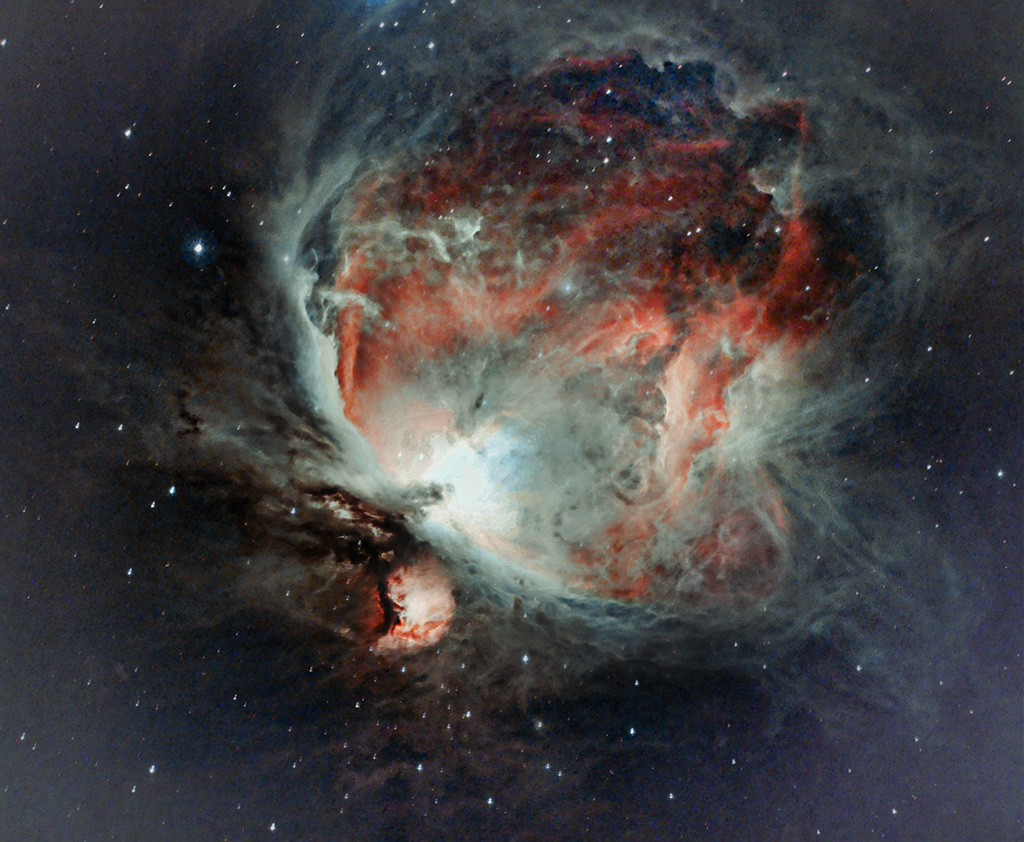
7/30/2023
Today I reprocessed some old data I had for Messier 16.
Messier 16 (M16), the famous Eagle Nebula, is a star-forming nebula with a young open star cluster located in Serpens.
M16 lies near the borders with the constellations Sagittarius and Scutum. The nebula is best known for the Pillars of Creation region, three large pillars of gas famously photographed by Hubble in 1995.
Also known as the Star Queen Nebula, M16 lies at a distance of 7,000 light years from Earth and has an apparent magnitude of 6.0. The cluster’s designation in the New General Catalogue is NGC 6611, while the nebula is referred to as IC 4703.
The Eagle Nebula occupies an area 70 by 55 light years in size, or 30 arc minutes of the sky, while the open cluster has a radius of 15 light years, corresponding to 7 arc minutes in angular diameter.
The name Eagle comes from the nebula’s shape, which is said to resemble an eagle with outstretched wings. American astronomer Robert Burnham, Jr. introduced the name Star Queen Nebula because the nebula’s central pillar reminded him of a silhouette of the Star Queen. (MESSIER OBJECTS)
Imaging Data:
Image: M16
Date: 6/11/2020, 8/9/2020/, 7/5/2021, 8/11/2021
Exposure: 60, 180, 300 seconds
Number of Lights: 515 for 12 hours and 22 minutes of which 63 lights for 3 hours and 49 minutes were used.
Gain: 120
Binning: 1X1
Imaging Software: Sequence Generator Pro
Camera: ZWO ASI294MC Pro using Hyperstar IV.
Cooling Temp: 0 Deg C
Filter: STC Astro Duo-Narrowband
Telescope: Celestron 1100HD SCT
Mount: 10MICRON GM1000HPS
Focuser: MicroTouch Focuser
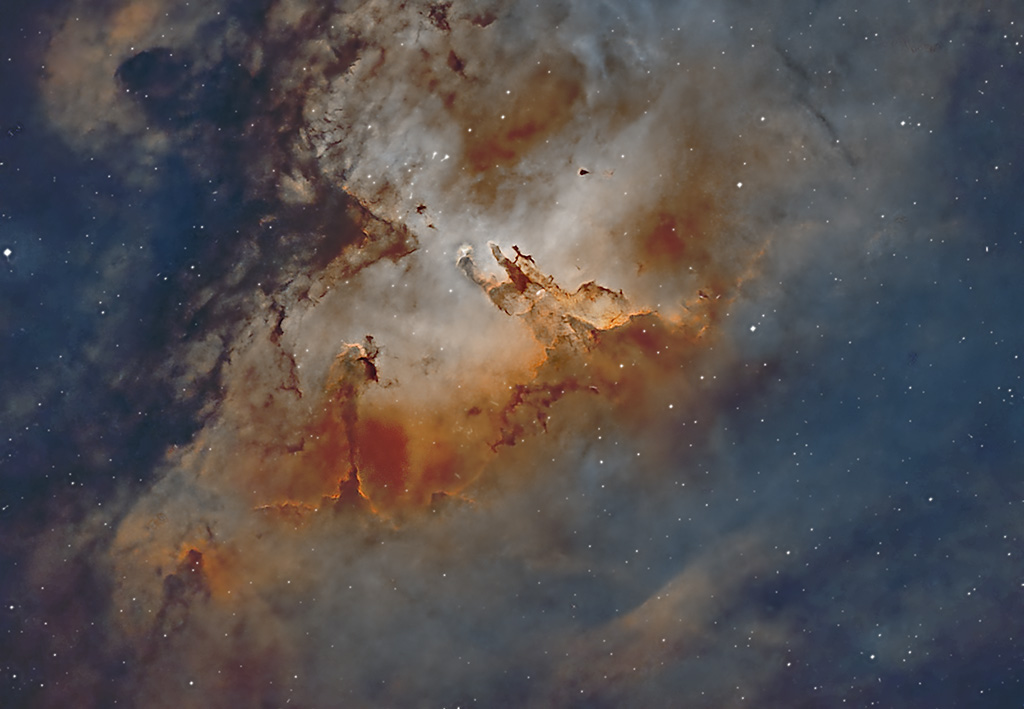
11/29/2021
The Soul Nebula is an emission nebula located in Cassiopeia. Several small open clusters are embedded in the nebula: CR 34, 632, and 634 (in the head) and IC 1848 (in the body). The object is more commonly called by the cluster designation IC 1848.
Small emission nebula IC 1871 is present just left of the top of the head, and small emission nebulae 670 and 669 are just below the lower back area.
The galaxies Maffei 1 and Maffei 2 are both nearby the nebula, although light extinction from the Milky Way makes them very hard to see. Once thought to be part of the Local Group, they are now known to belong to their own group- the IC 342/Maffei Group.
This complex is the eastern neighbor of IC1805 (Heart Nebula) and the two are often mentioned together as the "Heart and Soul".
Imaging Data:
Date: October 2022
Exposure= 180s, 300s, 600s for a total of 55h 30 minutes of which 10% were used
Binning = 1×1
Gain = 100
Camera Temperature= 0 deg C
Filter= IDAS NBZ NB filter
Camera: ASI2600MC PRO in Hyperstar configuration.
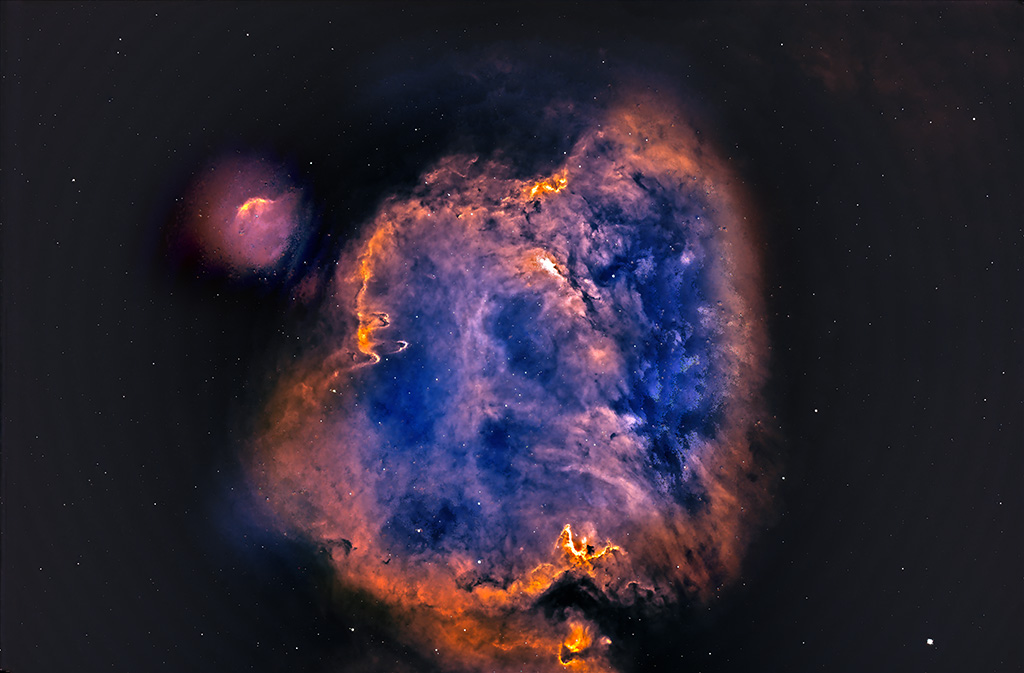
10-7-2022 Over the last month I’ve imaged IC 1805 the Heart Nebula. The Heart Nebula, IC 1805 lies some 7500 light years away from Earth and is located in the Perseus Arm of the Galaxy in the constellation Cassiopeia. It was discovered by William Herschel on 3 November 1787. This is an emission nebula showing glowing ionized hydrogen gas and darker dust lanes.
The very brightest part of this nebula (the knot at the western edge) is separately classified as NGC 896, because it was the first part of this nebula to be discovered.
The nebula's intense red output and its configuration are driven by the radiation emanating from a small group of stars near the nebula's center. This open cluster of stars known as Melotte 15 contains a few bright stars nearly 50 times the mass of our Sun, and many more dim stars that are only a fraction of our Sun's mass.
Imaging Data:
Date 9/1/22 – 10/5/22
Exposure= 180s & 600s – 534 images of which 265 were used for 20 hours 30 minutes
Binning = 1×1
Camera Temperature= -0 deg C
Camera = ZWO AS2600MC Pro in Hyperstar Position
Filter= IDAS NBZ narrow band filter
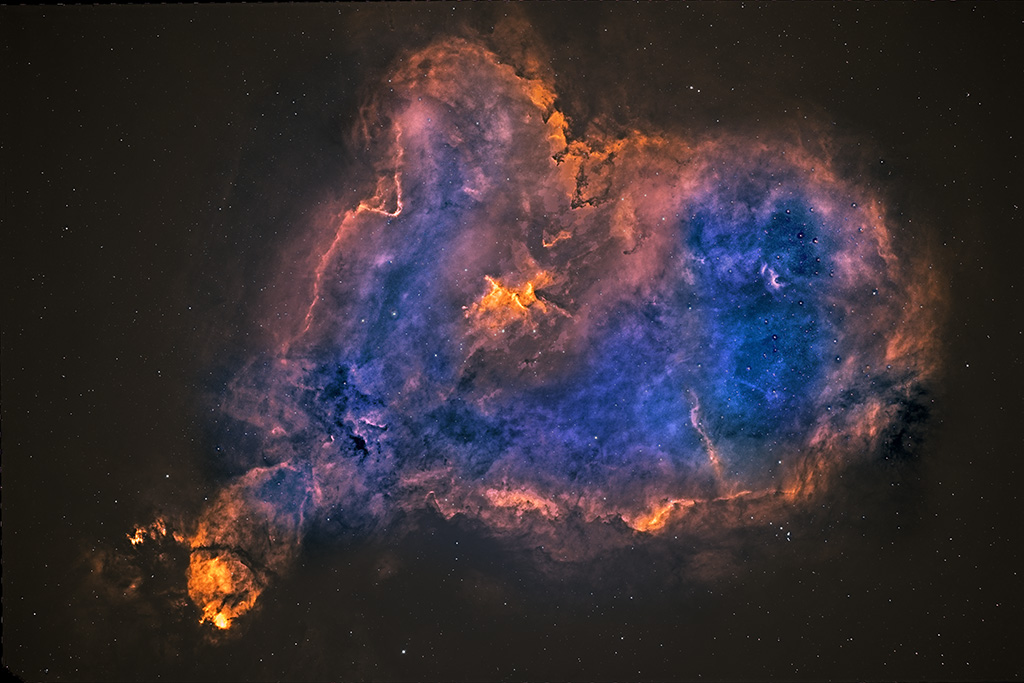
The Veil Nebula (NGC 6960) is a cloud of heated and ionized gas and dust in the constellation Cygnus.
It constitutes the visible portions of the Cygnus Loop, a supernova remnant, many portions of which have acquired their own individual names and catalogue identifiers. The source supernova was a star 20 times more massive than the Sun which exploded between 10,000 and 20,000 years ago. At the time of the explosion, the supernova would have appeared brighter than Venus in the sky, and visible in the daytime. The remnants have since expanded to cover an area of the sky roughly 3 degrees in diameter (about 6 times the diameter, and 36 times the area, of the full Moon). While previous distance estimates have ranged from 1200 to 5800light-years, a recent determination of 2400 light-years is based on direct astrometric measurements. (The distance estimates affect also the estimates of size and age.) Wikipedia
Imaging Data:
Provo, Utah
Bortle 5 sky
Date: 6/26/2021
Exposure: 300seconds x 60 of which 43 were used for 3H and 35M
Binning: 1×1
Gain: 120
Camera Temperature: -10 deg C
Filter: STC Astro Duo-Narrowband Filter
Camera: ASI294MC PRO in Hyperstar position
Mount : 10Micron GM1000HPS on pier
Processed with DSS, PI and PS
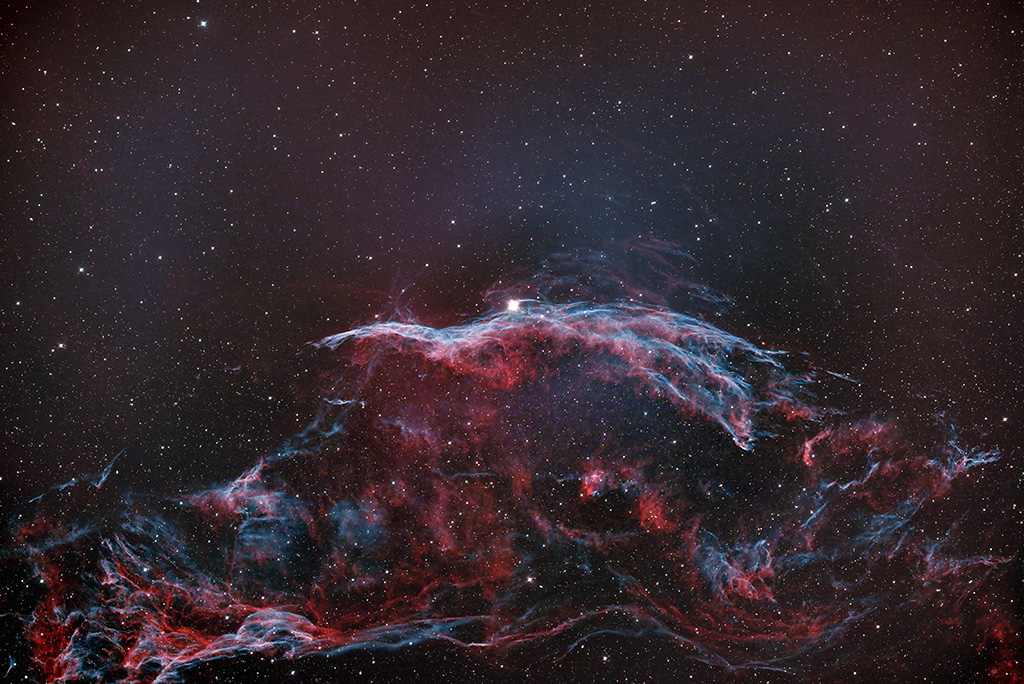
This is a set of images taken on June 21, 2023 of IC 1396. I've imaged this before – this time with a better camera.
The Elephant's Trunk Nebula is a concentration of interstellar gas and dust within the much larger ionized gas region IC 1396 located in the constellation Cepheus about 2,400 light years away from Earth. The piece of the nebula shown here is the dark, dense globule IC 1396A; it is commonly called the Elephant's Trunk nebula because of its appearance at visible light wavelengths, where there is a dark patch with a bright, sinuous rim. The bright rim is the surface of the dense cloud that is being illuminated and ionized by a very bright, massive star (HD 206267) that is just to the east of IC 1396A. The entire IC 1396 region is ionized by the massive star, except for dense globules that can protect themselves from the star's harsh ultraviolet rays.
The Elephant's Trunk Nebula is now thought to be a site of star formation, containing several very young (less than 100,000 yr) stars that were discovered in infrared images in 2003. Two older (but still young, a couple of million years, by the standards of stars, which live for billions of years) stars are present in a small, circular cavity in the head of the globule. Winds from these young stars may have emptied the cavity.
The combined action of the light from the massive star ionizing and compressing the rim of the cloud, and the wind from the young stars shifting gas from the center outward lead to very high compression in the Elephant's Trunk Nebula. This pressure has triggered the current generation of protostars. (Wikipedia)
Imaging Data:
Date June 21,2023
Exposure= 60 seconds for a total of 370 lights of which 18 were used for 18 m.
Gain=100
Binning = 1×1
Camera Temperature= -0 deg C
Filter= IDAS-NBZ Narrowband Filter
Camera: ASI2600MC PRO in Hyperstar configuration.
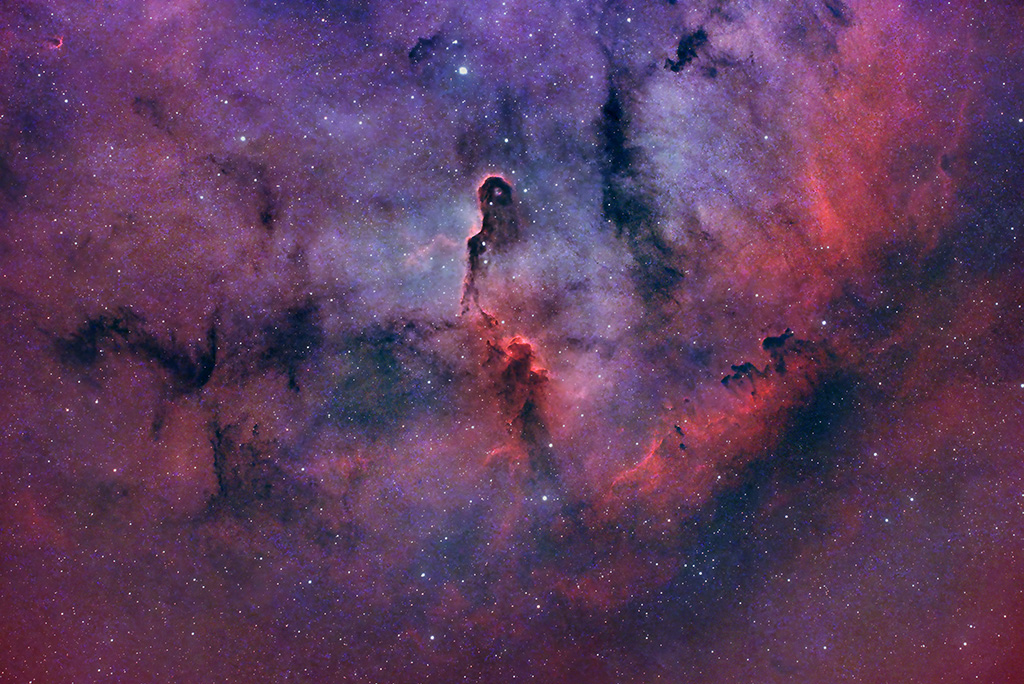
8/7/2023
This is a set of images taken on August 6, 2023 of IC 1396. I've imaged this before – this time with a better camera, and this time to image the surrounding area also.
The Elephant's Trunk Nebula is a concentration of interstellar gas and dust within the much larger ionized gas region IC 1396 located in the constellation Cepheus about 2,400 light years away from Earth. The piece of the nebula shown here is the dark, dense globule IC 1396A; it is commonly called the Elephant's Trunk nebula because of its appearance at visible light wavelengths, where there is a dark patch with a bright, sinuous rim. The bright rim is the surface of the dense cloud that is being illuminated and ionized by a very bright, massive star (HD 206267) that is just to the east of IC 1396A. The entire IC 1396 region is ionized by the massive star, except for dense globules that can protect themselves from the star's harsh ultraviolet rays.
The Elephant's Trunk Nebula is now thought to be a site of star formation, containing several very young (less than 100,000 yr) stars that were discovered in infrared images in 2003. Two older (but still young, a couple of million years, by the standards of stars, which live for billions of years) stars are present in a small, circular cavity in the head of the globule. Winds from these young stars may have emptied the cavity.
The combined action of the light from the massive star ionizing and compressing the rim of the cloud, and the wind from the young stars shifting gas from the center outward lead to very high compression in the Elephant's Trunk Nebula. This pressure has triggered the current generation of protostars. (Wikipedia)
Imaging Data:
Provo, Utah
Bortle 5 sky
Date August 6,2023
Image: IC 1398
Size: 11.7’
Magnitude: 9.8
Exposure= 180 seconds and 51 lights for a total of 1 hour and 33 minutes
Gain=100
Binning = 1×1
Camera Temperature= 0 deg C
Filter= IDAS-NBZ Narrowband Filter
Camera: ASI2600MC PRO in Hyperstar configuration.
Telescope: Celestron 1100 Edge HD
Mount : 10MICRON GM1000HPS
Processed with DSS, PI and PS
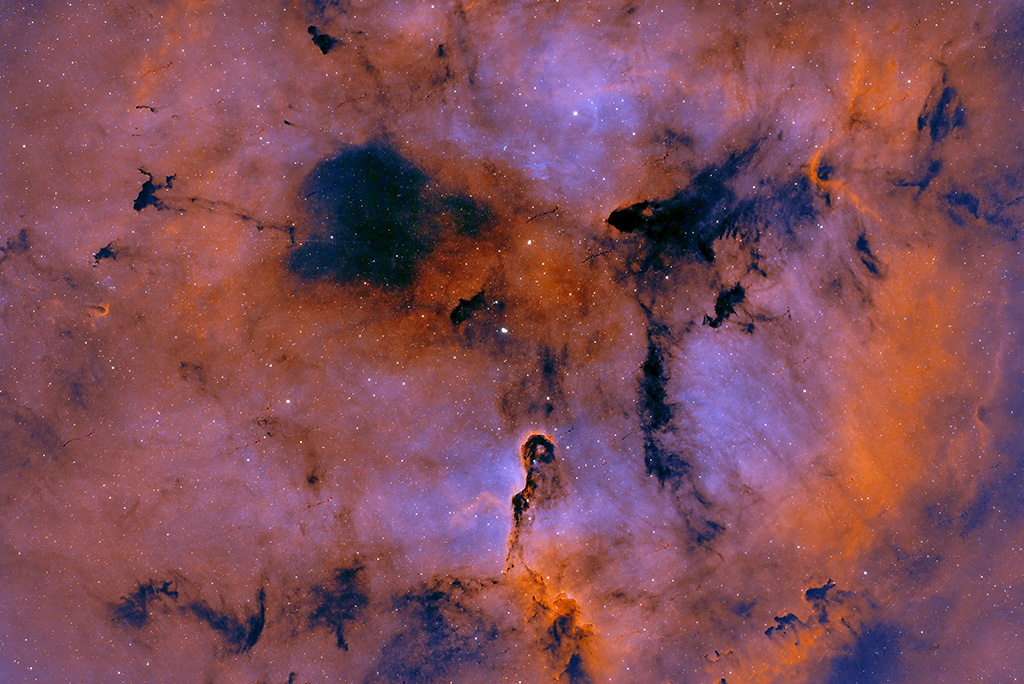
8/29/2019
The Pleiades , also known as the Seven Sisters and Messier 45, are an open star cluster containing middle-aged, hot B-type stars located in the constellation of Taurus. It is among the nearest star clusters to Earth and is the cluster most obvious to the naked eye in the night sky.
The cluster is dominated by hot blue and luminous stars that have formed within the last 100 million years. Reflection nebulae around the brightest stars were once thought to be left over material from the formation of the cluster but are now considered likely to be an unrelated dust cloud in the interstellar medium through which the stars are currently passing.
Computer simulations have shown that the Pleiades were probably formed from a compact configuration that resembled the Orion Nebula. Astronomers estimate that the cluster will survive for about another 250 million years, after which it will disperse due to gravitational interactions with its galactic neighborhood. (Wikipedia)
Imaging Data:
Provo, Utah
Bortle 5 sky
Date: 8/26/19
Exposure= 30s x 303 of which 273 were used
Binning = 1×1
Gain = 120
Camera Temperature= 0 deg C
Filter= Astronomik L-2 UV-IR Blocking Filter
Camera = ASI294MC PRO in Hyperstar position
Processed with DSS, PI and PS
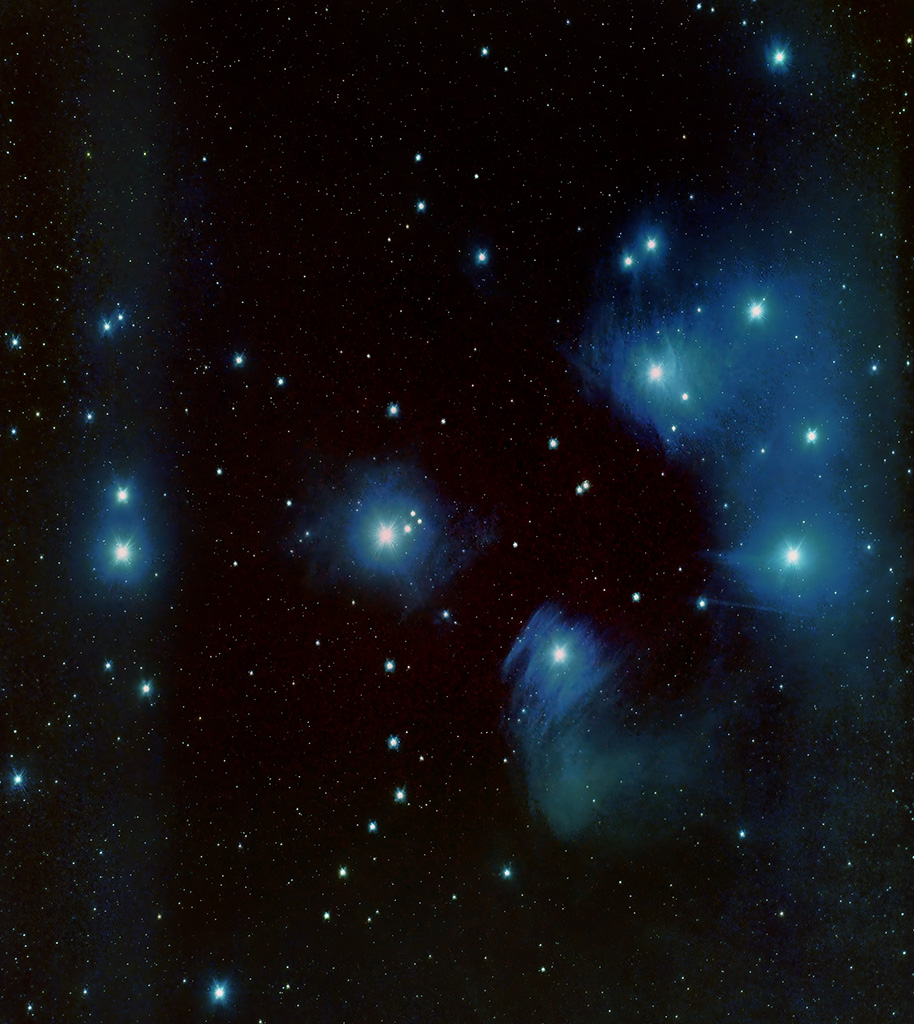
9/2/2019
I imaged NGC 281 on August 31, 2019. It is composed of 360 x 60s images.
NGC 281, IC 11 or Sh2-184 is a bright emission nebula and part of an H II region in the northern constellation of Cassiopeia and is part of the Milky Way's Perseus Spiral Arm. This 20×30 arcmin sized nebulosity is also associated with open cluster IC 1590, several Bok globules and the multiple star, B 1. It collectively forms Sh2-184, spanning over a larger area of 40 arcmin. A recent distance from radio parallaxes of water masers at 22 GHz made during 2014 is estimated it lies 2.82±0.20 kpc. (9200 ly.) from us. Colloquially, NGC 281 is also known as the Pacman Nebula for its resemblance to the video game character.
Imaging Data:
Date: 8/31/19
Exposure= 60s x 360
Binning = 1×1
Gain = 120
Camera Temperature= 0 deg C
Filter= STC Astro Duo-Narrowband Filter
Camera = ASI294MC PRO in Hyperstar position
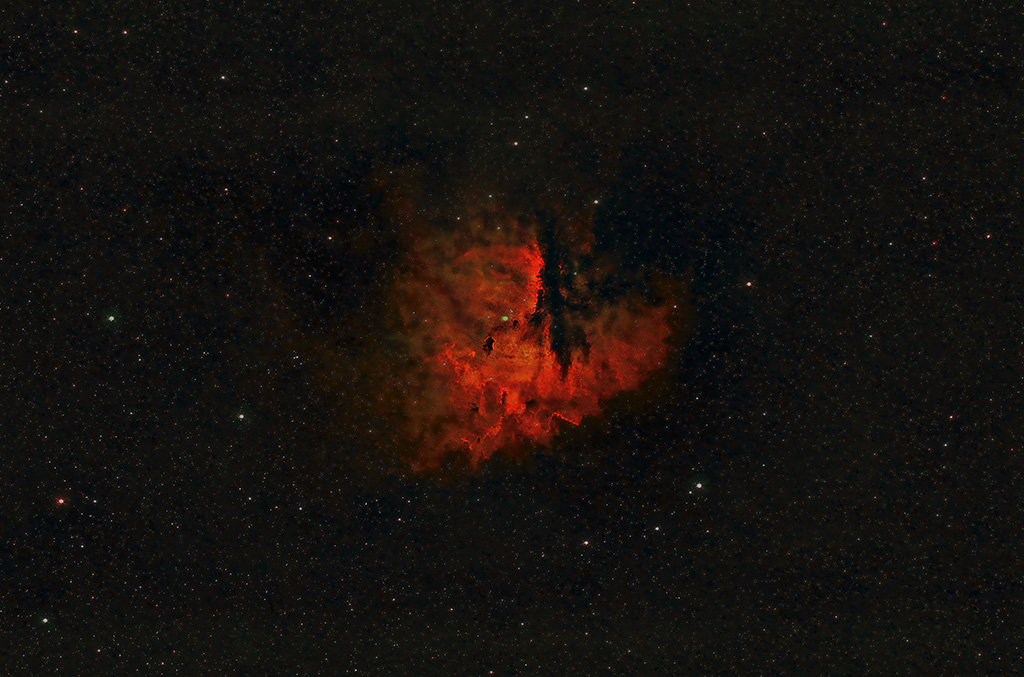
10/4/2019
This image of the North sky Milky Way is composed of 10 x 120 second images. These were taken at a very dark site about 12 miles North of Moab Utah on Sept 30, 2019. I used my Star Adventurer tracker on my tripod to track with. The camera I used was my Nikon D850 coupled with my Tamron SP 15-30mm lens. The ISO was set to 800.
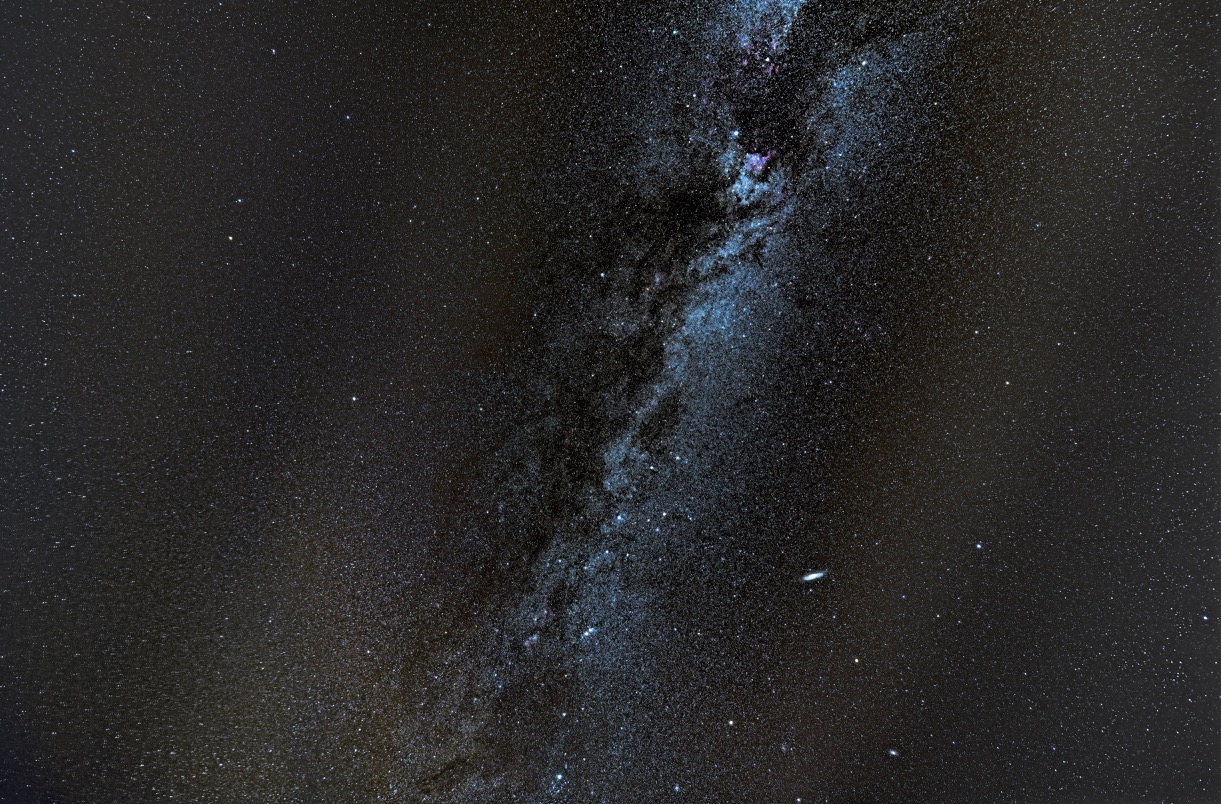
Picture saved with settings applied.
10/4/2019
This image of the South of the sky Milky Way is composed of 29 x 120 second images. These were taken at a very dark site about 12 miles North of Moab Utah on Sept 30, 2019. I used my Star Adventurer tracker on my tripod to track with. The camera I used was my Nikon D850 coupled with my Tamron SP 15-30mm lens. The ISO was set to 800.
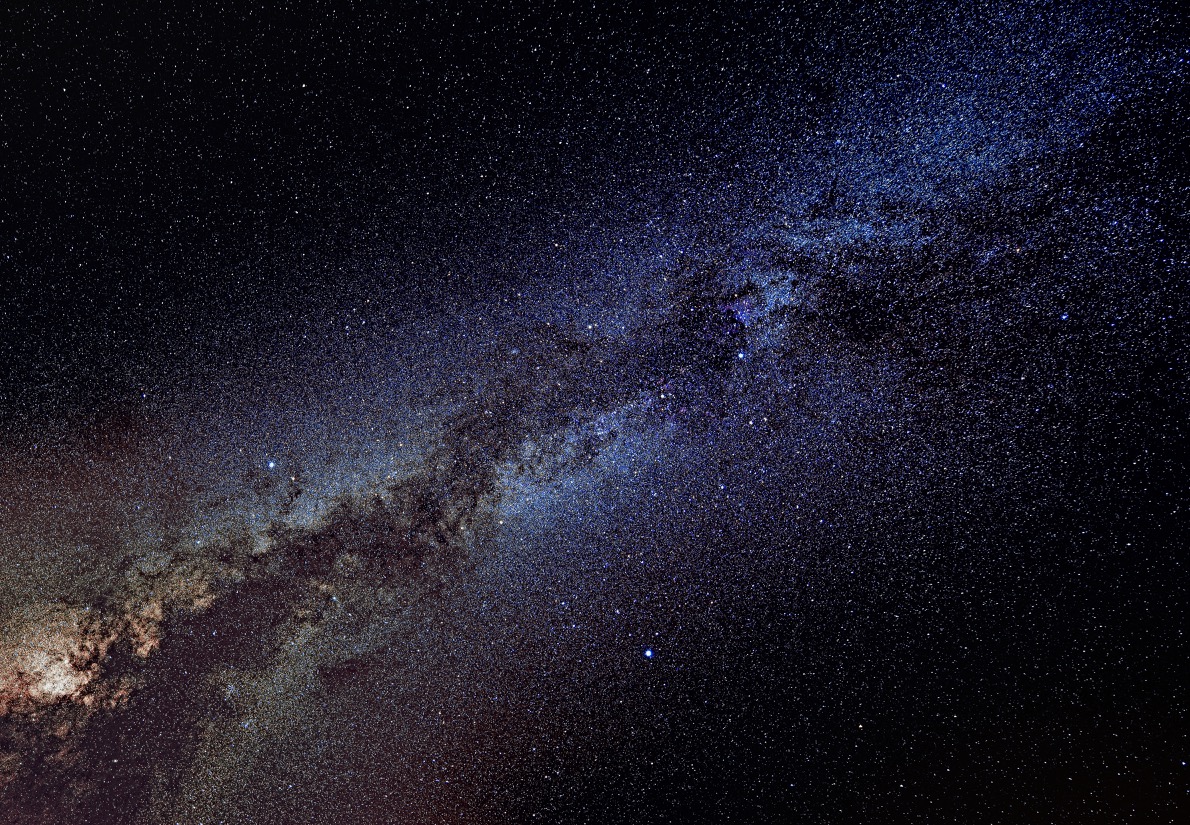
The Omega Nebula is (Messier 17) between 5,000 and 6,000 light-years from Earth and it spans some 15 light-years in diameter. The cloud of interstellar matter of which this nebula is a part is roughly 40 light-years in diameter and has a mass of 30,000 solar masses. The total mass of the Omega Nebula is an estimated 800 solar masses.
It is considered one of the brightest and most massive star-forming regions of our galaxy. Its local geometry is similar to the Orion Nebula except that it is viewed edge-on rather than face-on.
The open cluster NGC 6618 lies embedded in the nebulosity and causes the gases of the nebula to shine due to radiation from these hot, young stars; however, the actual number of stars in the nebula is much higher – up to 800, 100 of spectral type earlier than B9, and 9 of spectral type O, plus over a thousand stars in formation on its outer regions. It is also one of the youngest clusters known, with an age of just 1 million years.
The luminous blue variable HD 168607, located in the south-east part of the Omega nebula, is generally assumed to be associated with it; its close neighbor, the blue hypergiant HD 168625, may be too.
The Swan portion of M17, the Omega Nebula in the Sagittarius nebulosity is said to resemble a barber's pole. (Wikipedia)
Imaging Data:
Date: 8/14/19
Exposure= 30s x 120 of which 67 were used
Binning = 1×1
Gain + 200
Camera Temperature= 0 deg C
Filter= STC Astro Duo-Narrowband Filter
Camera = ASI294MC PRO in Hyperstar position
Processed in DSS (lights only) then PS
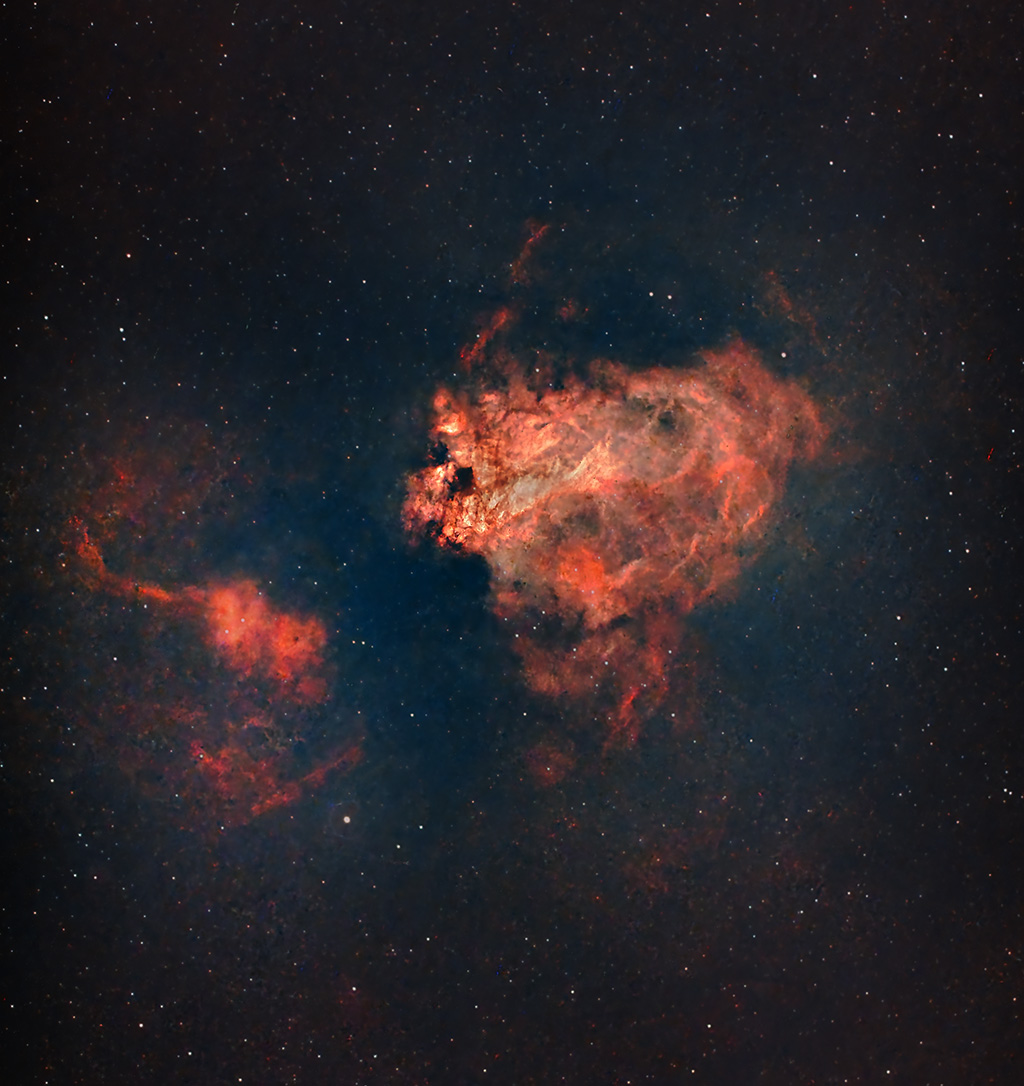
NGC 7023
The Iris Nebula, also known as NGC 7023 and Caldwell 4, is a bright reflection nebula and Caldwell object in the constellation Cepheus. NGC 7023 is actually the cluster within the nebula, LBN 487, and the nebula is lit by a magnitude +7 star, SAO 19158. It shines at magnitude +6.8. It is located near the Mira-type variable star T Cephei, and near the bright magnitude +3.23 variable star Beta Cephei (Alphirk). It lies 1,300 light-years away and is six light-years across. (Wikipedia)
Imaging Data:
Image: NGC 7023
Date 6/10/19, 8/22/19, 7/9/20, 7/11/20
Exposure: 120 sec & 180 sec for 12 hours of images
Binning = 1×1
Gain = 120
Camera Temperature= 0 deg C
Filter= STC Astro Duo-Narrowband Filter
Camera = ASI294MC PRO in Hyperstar position
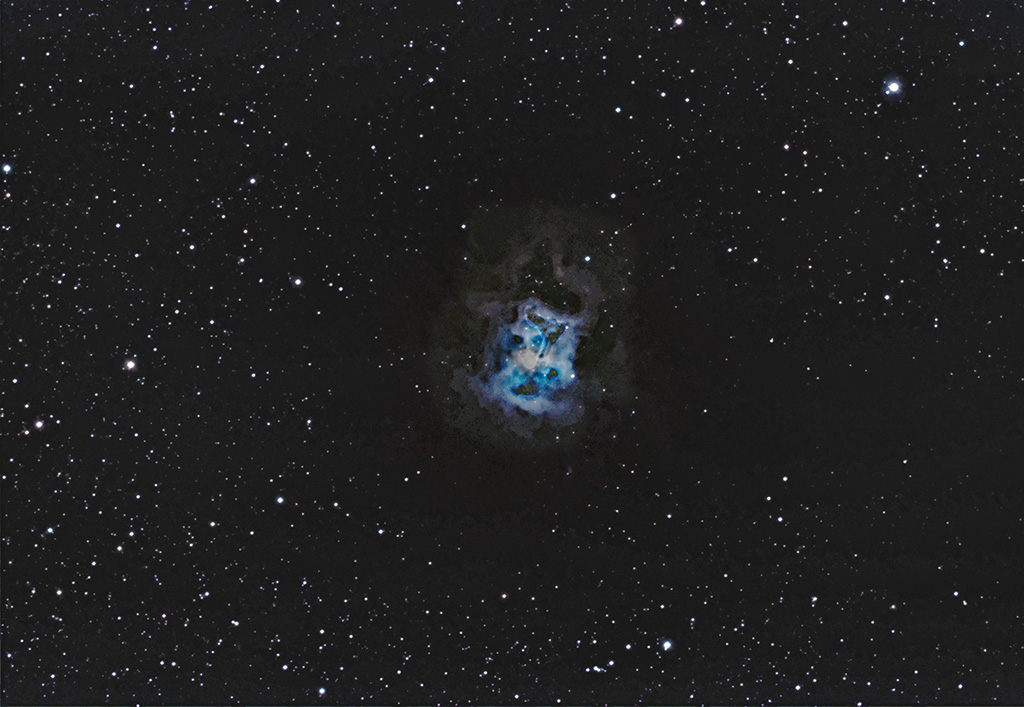
Messier 102 (also known as M102 or the Spindle Galaxy) is a galaxy listed in the Messier Catalogue that has not been identified unambiguously. Its original discoverer Pierre Méchain later said that it was a duplicate observation of Messier 101, but more recent historical evidence favors that it is NGC 5866,[ although other galaxies have been suggested as possible identities. (Wikipedia)
Imaging Data:
Date: 11/7/14
Gain = 1600
Camera = Canon 60Da
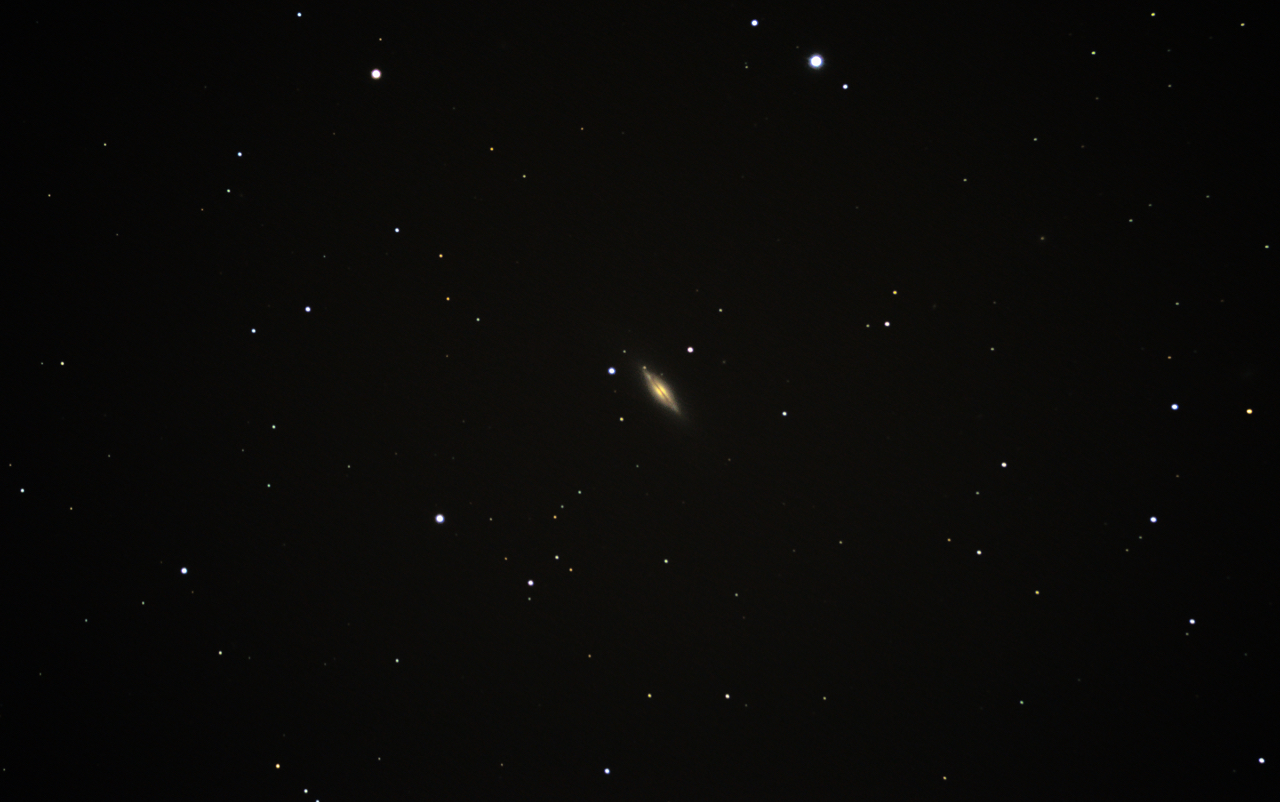 11-26-2019
11-26-2019
The Andromeda Galaxy , also known as Messier 31, or NGC 224 and originally the Andromeda Nebula, is a spiral galaxy approximately 780 kiloparsecs (2.5 million light-years) from Earth, and the nearest major galaxy to the Milky Way. The galaxy's name stems from the area of the Earth's sky in which it appears, the constellation of Andromeda.
The virial mass of the Andromeda Galaxy is of the same order of magnitude as that of the Milky Way, at a trillion solar masses. The Andromeda Galaxy has a diameter of about 220,000 light-years, making it the largest member of the Local Group at least in terms of extension, if not mass.
The number of stars contained in the Andromeda Galaxy is estimated at one trillion (1×1012), or roughly twice the number estimated for the Milky Way.
The Milky Way and Andromeda galaxies are expected to collide in ~4.5 billion years, merging to form a giant elliptical galaxy or a large lenticular galaxy. With an apparent magnitude of 3.4, the Andromeda Galaxy is among the brightest of the Messier objects making it visible to the naked eye from Earth on moonless nights, even when viewed from areas with moderate light pollution. (Wikipedia)
Imaging Data
Date: 11/18/2019
Exposure: 30 seconds
Number of Lights: 320
Gain: 120
Camera Type: ZWO ZSI294MC PRO
Filter: Astronomik UV-IR
Temp: -10 deg C
Telescope: Celestron 1100HS SCT
Mount: 10Micron
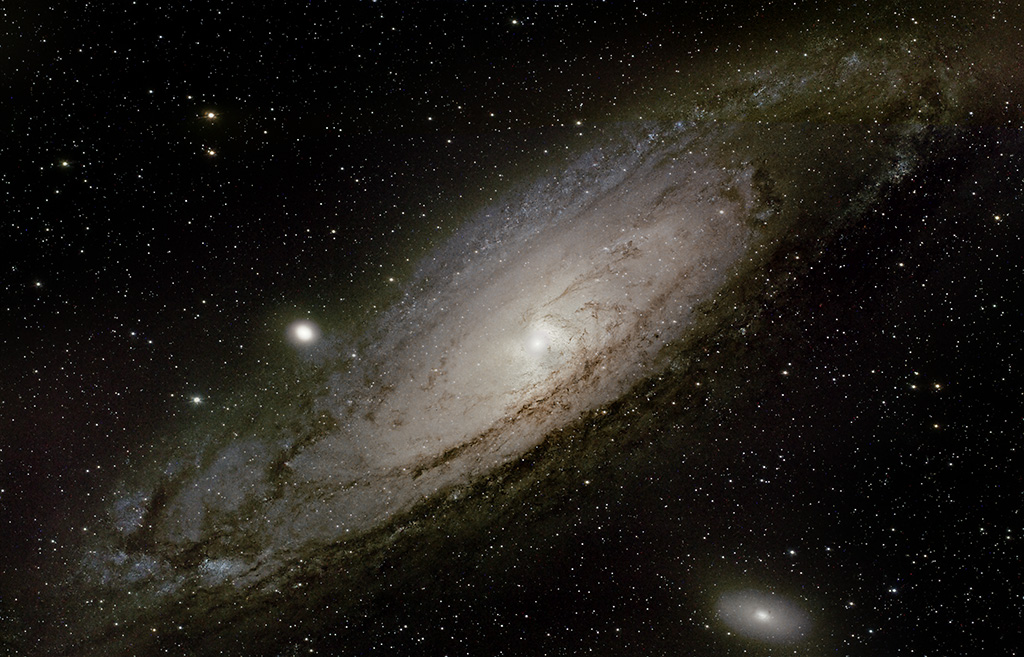
12-21-2019
This is an image of NGC 2264 which is a combination of the Cone Nebula and the Christmas Tree Nebula. This is located about 2600 light years from us.
Imaging Data:
Date: 12/19/19 Reprocessed on 8/22/2023
Exposure: 30seconds x 540 of which 154 where used
Binning: 1×1
Gain: 120
Camera Temperature: -10 deg C
Filter: STC Astro Duo-Narrowband Filter
Camera: ASI294MC PRO in Hyperstar position
Mount : 10Micron GM1000HPS on pier
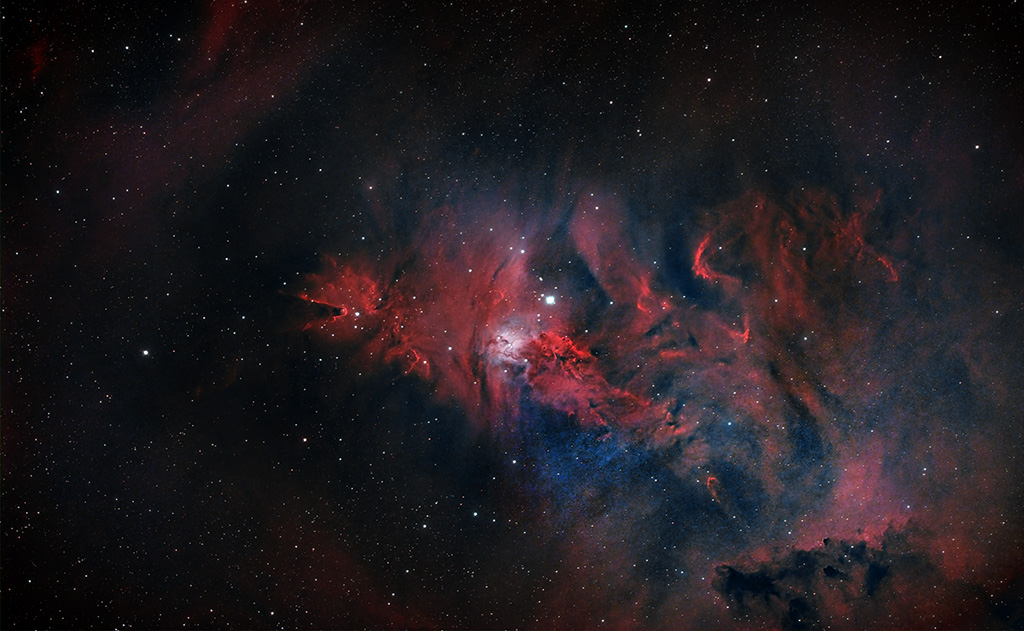
2/27/2022
This is a combination of M81 and M81 taken on the morning of 5/7/2020. It is from a stack of 40 exposures of 300 seconds each, stacked in Images Plus, processed with PixInsight and finally Photoshop.
Messier 81 (also known as NGC 3031 or Bode's Galaxy) is a spiral galaxy about 12 million light-years away in the constellation Ursa Major. Due to its proximity to Earth, large size and active galactic nucelus, which harbors a supermassive black hole, Messier 81 has been studied extensively by professional astronomers.
Messier 82 (also known as NGC 3034, Cigar Galaxy or M82) is the prototype nearby starburst galaxy about 12 million light-years away in the constellation Ursa Major. The starburst galaxy is five times brighter than the whole Milky Way and one hundred times brighter than our galaxy's center.
In 2005, the Hubble Space Telescope revealed 197 young massive clusters in the starburst core. The average mass of these clusters is around 2×105 M, hence the starburst core is a very energetic and high-density environment. Throughout the galaxy's center, young stars are being born 10 times faster than they are inside our entire Milky Way Galaxy.
Imaging Data:
Date: 2/27/2022 reprocessed on 1/18/2024
Exposure= 300s x 70 of which 49 were used for 4h 5m
Binning = 2×2
Gain = 100
Camera Temperature= -10 deg C
Filter= IADS-NBZ Narrowband Filter
Camera = ASI2600MC PRO in Hyperstar position
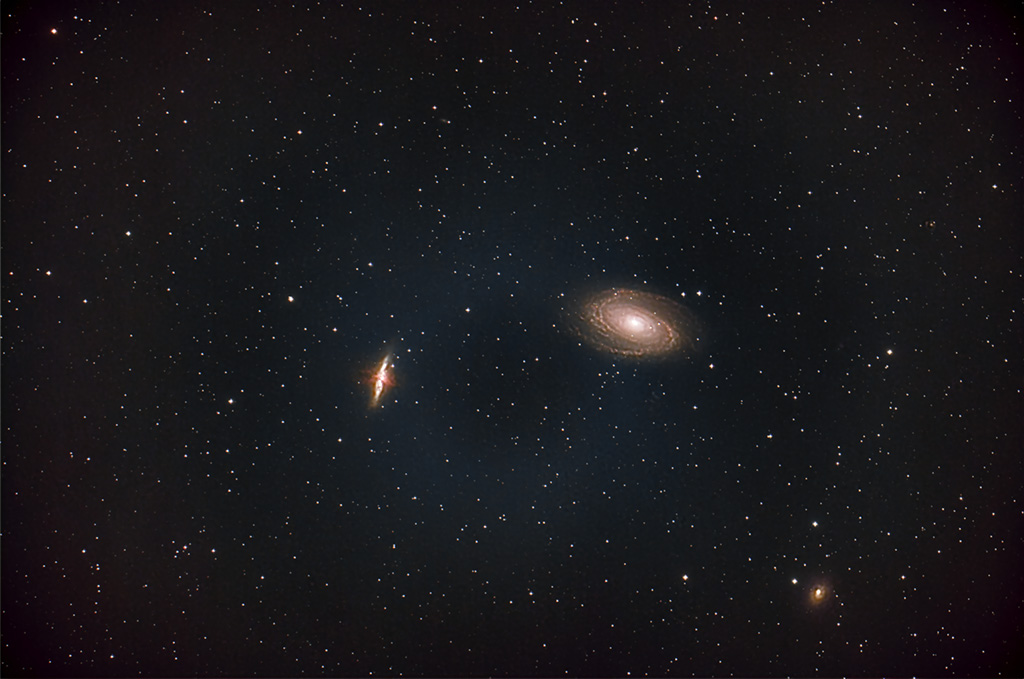
5/7/2020
Messier 3 (M3 or NGC 5272) is a globular cluster of stars in the northern constellation of Canes Venatici. It was discovered on May 3, 1764, and was the first Messier object to be discovered by Charles Messier himself. Messier originally mistook the object for a nebula without stars. This mistake was corrected after the stars were resolved by William Herschel around 1784. Since then, it has become one of the best-studied globular clusters. Identification of the cluster's unusually large variable star population was begun in 1913 by American astronomer Solon Irving Bailey and new variable members continue to be identified up through 2004.
Many amateur astronomers consider it one of the finest northern globular clusters, following only Messier 13. M3 has an apparent magnitude of 6.2,[5] making it a difficult naked eye target even with dark conditions. With a moderate-sized telescope, the cluster is fully defined. It can be a challenge to locate through the technique of star hopping, but can be found by looking almost exactly halfway along an imaginary line connecting the bright star Arcturus to Cor Caroli. Using a telescope with a 25 cm (9.8 in) aperture, the cluster has a bright core with a diameter of about 6 arcminutes and spans a total of 12 arcminutes.
This cluster is one of the largest and brightest, and is made up of around 500,000 stars. It is estimated to be 8 billion years old. It is located at a distance of about 33,900 light-years away from Earth (Wikipedia)
Imaging Data:
Date: 5/7/2020
Exposure= 300s x 40 of which 7 were used for a total of 35 minutes
Gain=120
Binning = 1×1
Camera Temperature=-10 deg C
Filter= STC Astro Duo-Narrowband Filter
Camera: ASI294MC PRO in Hyperstar configuration
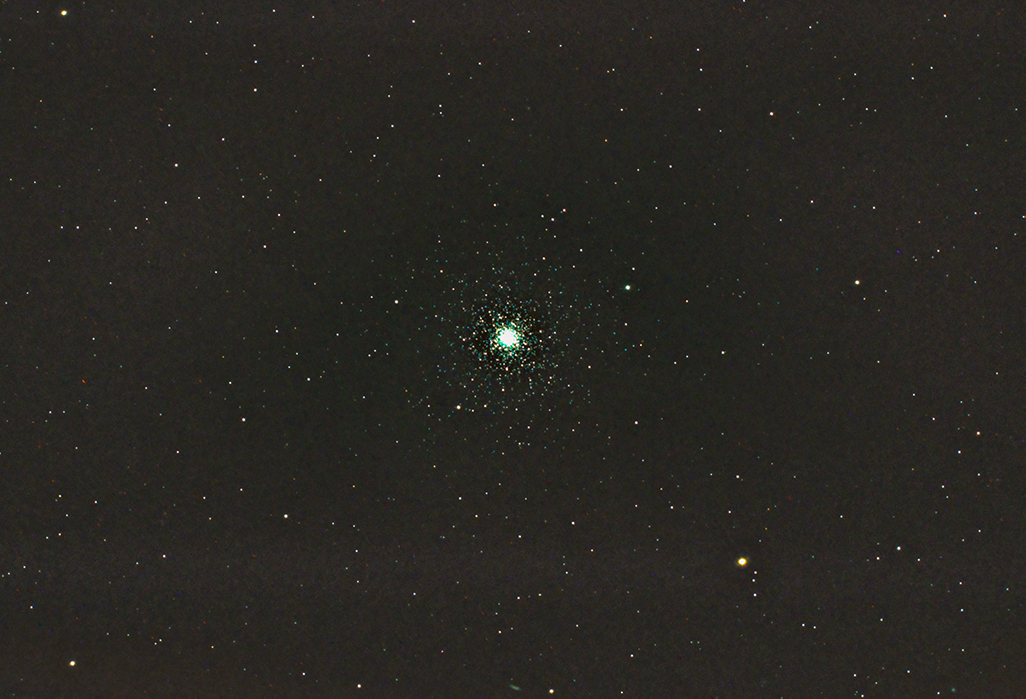
The Sombrero Galaxy (also known as Messier Object 104, M104 or NGC 4594) is a galaxy in the constellation Virgo found 9.55 megaparsecs (31.1 million light-years) from Earth. The galaxy has a diameter of approximately 15 kiloparsecs (49,000 light-years), 30% the size of the Milky Way. It has a bright nucleus, an unusually large central bulge, and a prominent dust lane in its inclined disk. The dark dust lane and the bulge give this galaxy the appearance of a sombrero hat. Astronomers initially thought that the halo was small and light, indicative of a spiral galaxy, but the Spitzer Space Telescope found that the dust ring around the Sombrero Galaxy is larger and more massive than previously thought, indicative of a giant elliptical galaxy. The galaxy has an apparent magnitude of +8.0, making it easily visible with amateur telescopes, and it is considered by some authors to be the galaxy with the highest absolute magnitude within a radius of 10 megaparsecs of the Milky Way. Its large bulge, its central supermassive black hole, and its dust lane all attract the attention of professional astronomers. Wikipedia
Imaging Data:
Date: 5/8/2020
Exposure= 300s x 17
Binning = 1×1
Gain = 120
Camera Temperature= -10 deg C
Filter= STC Astro Duo-Narrowband Filter
Camera = ASI294MC PRO in Hyperstar position
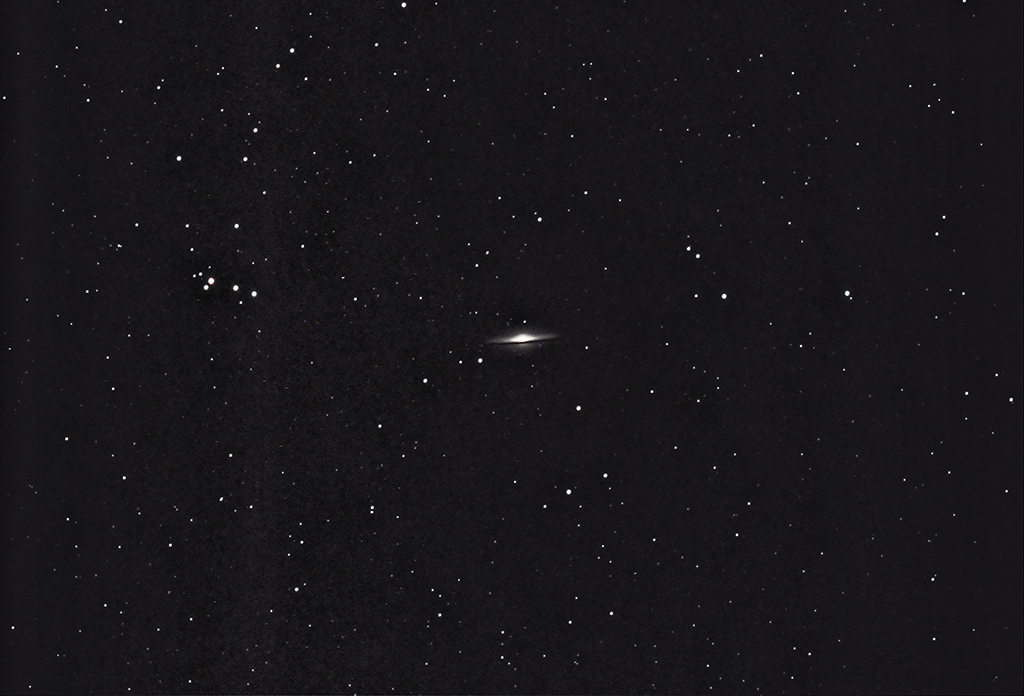
Messier 106 (also known as NGC 4258) is an intermediate spiral galaxy in the constellation Canes Venatici. It was discovered by Pierre Méchain in 1781. M106 is at a distance of about 22 to 25 million light-years away from Earth. M106 contains an active nucleus classified as a Type 2 Seyfert, and the presence of a central supermassive black hole has been demonstrated from radio-wavelength observations of the rotation of a disk of molecular gas orbiting within the inner light-year around the black hole. NGC 4217 is a possible companion galaxy of Messier 106. A Type II supernova was observed in M106 in May 2014. Wikipedia
Imaging Data:
Date: 5/8/2020
Exposure= 300s x 59
Binning = 1×1
Gain = 120
Camera Temperature= -10 deg C
Filter= STC Astro Duo-Narrowband Filter
Camera = ASI294MC PRO in Hyperstar position
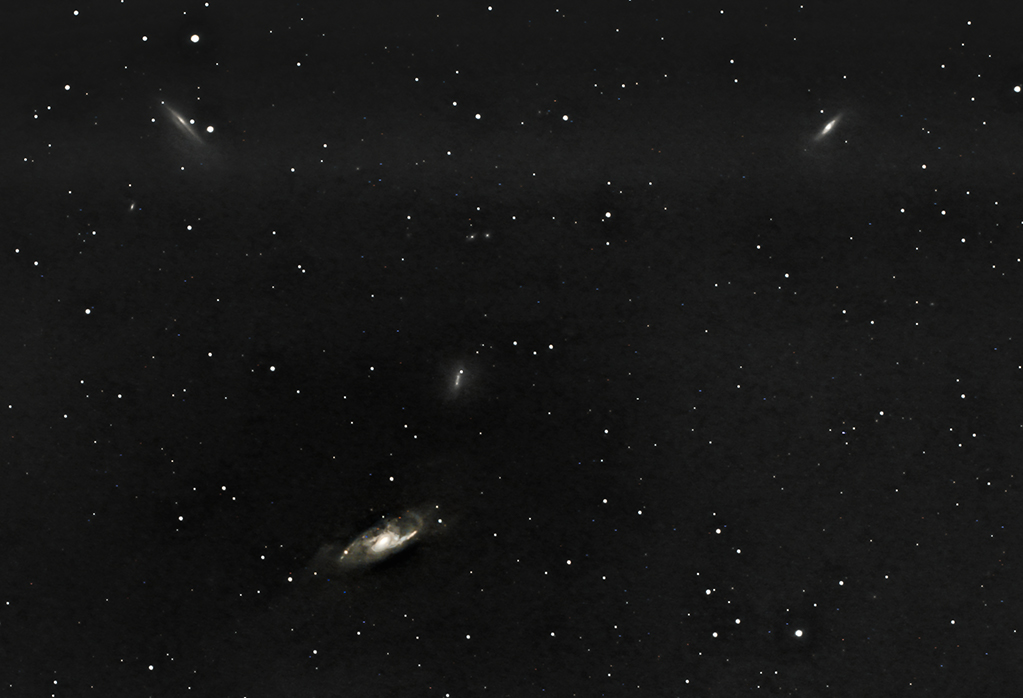
The Pinwheel Galaxy (also known as Messier 101, M101 or NGC 5457) is a face-on spiral galaxy distanced 21 million light-years (six megaparsecs) away from Earth in the constellation Ursa Major. Discovered by Pierre Méchain on March 27, 1781, it was communicated to Charles Messier who verified its position for inclusion in the Messier Catalogue as one of its final entries.
M101 is a large galaxy, with a diameter of 170,000 light-years. By comparison, the Milky Way has a diameter of 100,000 light years. It has around a trillion stars, twice the number in the Milky Way. It has a disk mass on the order of 100 billion solar masses, along with a small central bulge of about 3 billion solar masses. Wikipedia
Imaging Data: Redone on Sept 14,2023
Provo, Utah
Bortle 5 sky
Date: April 24, 26, 28 and May 9 2020, March 1,2021, June 8,2021
Exposure= 60,120,300 sec for a total integration time of 21 hours 2 minutes
Binning = 1×1
Camera Temperature= -10 deg C
Camera ZWO ASI294MC PRO in Hyperstar postition
Mount 10Micron GM100HPS0
Filters= STC Astro Duo-Narrowband Filter & Astronomik UV-IP Blocking Filter
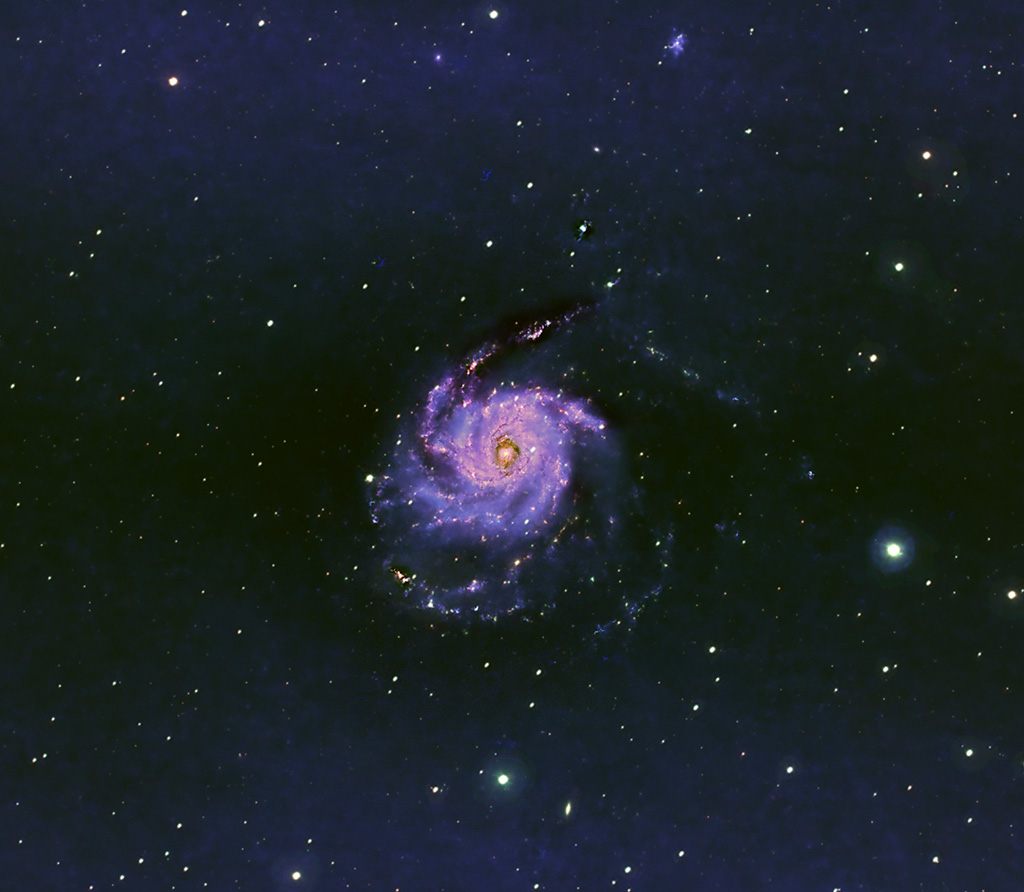
5/24/2020
The Whirlpool Galaxy, also known as Messier 51, and NGC 5194, is an interacting grand-design spiral galaxy with a Seyfert 2 active galactic nucleus. It lies in the constellation Canes Venatici, and was the first galaxy to be classified as a spiral galaxy. Its distance is estimated to be 23 million light-years away from Earth.
The galaxy and its companion, NGC 5195, are easily observed by amateur astronomers, and the two galaxies may be seen with binoculars. The Whirlpool Galaxy has been extensively observed by professional astronomers, who study it to understand galaxy structure (particularly structure associated with the spiral arms) and galaxy interactions. (Wikipedia)
Date: 6/28/19 & 5/23/20
Exposure= 60s x 64 (6/28/19)
60s x 289 (5/23/20)
Total exposure time 2 h 58m
Binning = 1×1
Gain = 120
Camera Temperature= 0 deg C
Filter= UV/IR FILTER 6/28/19
STC Astro Duo-Narrowband Filter 5/23/20
Camera = ASI294MC PRO in Hyperstar position
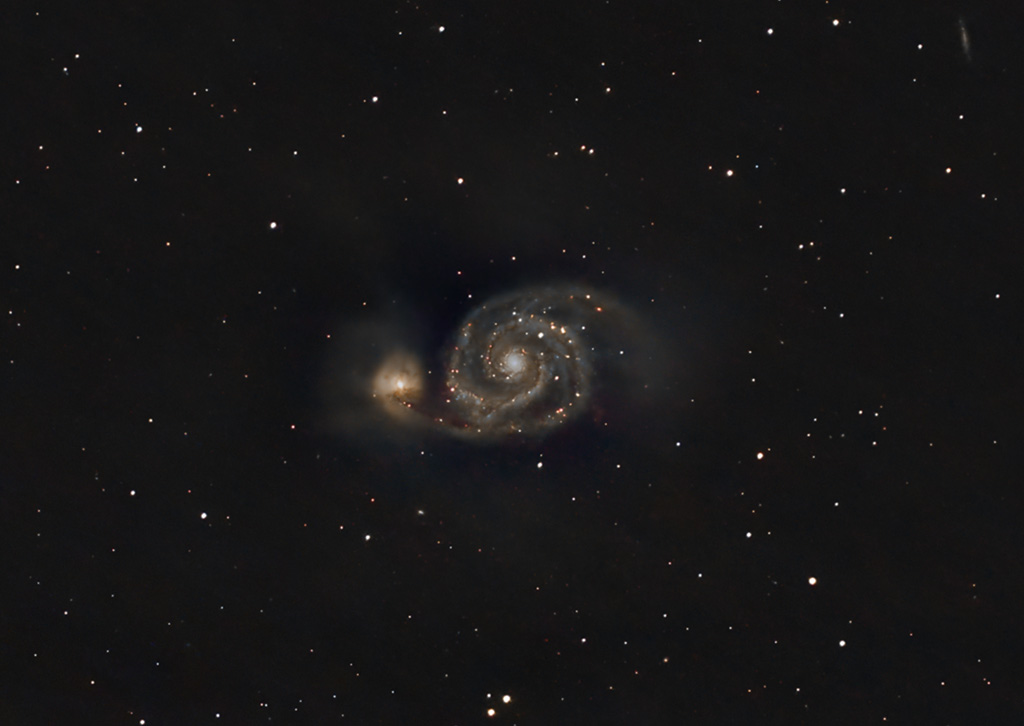
6/7/2020 Here is Messier 39 which I imaged some time back:
Messier 39 or M39, also known as NGC 7092, is an open cluster of stars in the constellation of Cygnus, positioned two degrees to the south of the star Pi Cygni and around 9° east-northeast of Deneb. The cluster was discovered by Guillaume Le Gentil in 1749, then Charles Messier added it to his catalogue in 1764. When observed in a small telescope at low power the cluster shows around two dozen members, but it is best observed with binoculars. It has a total integrated magnitude (brightness) of 5.5 and spans an angular diameter of 29 arcminutes – about the size of the full Moon. M39 is at a distance of about 1,010 light-years (311 parsecs) from the Sun.
This cluster has an estimated mass of 232 M and a linear tidal radius of 8.6±1.8 pc. Of the 15 brightest components, six form binary star systems with one more suspected. HD 205117 is a probable eclipsing binary system with a period of 113.2 days that varies by 0.051 in visual magnitude. Both members appear to be subgiant stars. There are at least five chemically peculiar stars in the cluster and ten[ suspected short-period variable stars. (Wikipedia)
Imaging Data:
Date: 6/27/19
Exp = 30s x 480 of which 377 were used
Gain = 200
Temp = 0 Deg C
Binning = 1×1
Camera = ZWO AST294MC Pro in Hyperstar position
Filter = Astronomik L-2 UV-IR Blocking Filter
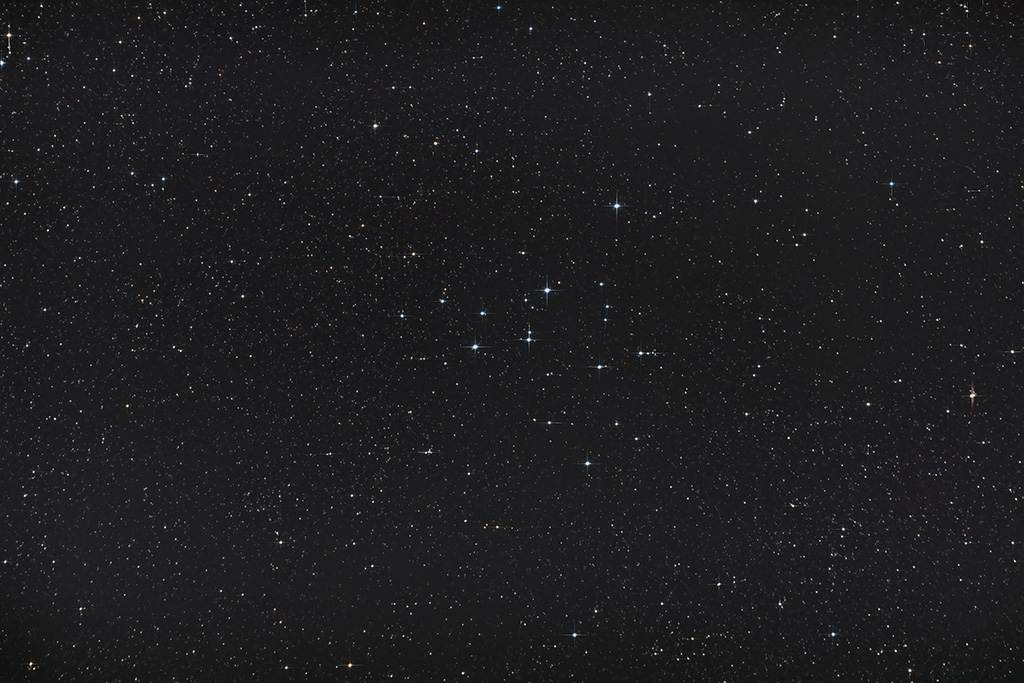
IC 5146 (also Caldwell 19, Sh 2-125, and the Cocoon Nebula) is a reflection/emission nebula and Caldwell object in the constellation Cygnus. The NGC description refers to IC 5146 as a cluster of 9.5 mag stars involved in a bright and dark nebula. The cluster is also known as Collinder 470. It shines at magnitude +10.0/+9.3/+7.2. Its celestial coordinates are RA 21h 53.5m, dec +47° 16′. It is located near the naked-eye star Pi Cygni, the open cluster NGC 7209 in Lacerta, and the bright open cluster M39. The cluster is about 4,000 ly away, and the central star that lights it formed about 100,000 years ago; the nebula is about 12 arcmins across, which is equivalent to a span of 15 light years. WIKIPEDIA
Imaging Data:
Provo, Utah
Bortle 5 sky
Date: 7/20 & 21/2023
Exposure= 180 seconds x 234 of which 65 were used for a total of 3h 15m
Binning = 1×1
Camera Temperature= 0 deg C
Camera Gain= 100
Filter= IDAS-NBZ Narrowband Filter
Camera: ASI2600MC PRO in Hyperstar IV configuration.
Telescope: Celestron 1100 Edge HD
Mount: 10Micron GM1000HPS
Processed with DSS, PI and PS
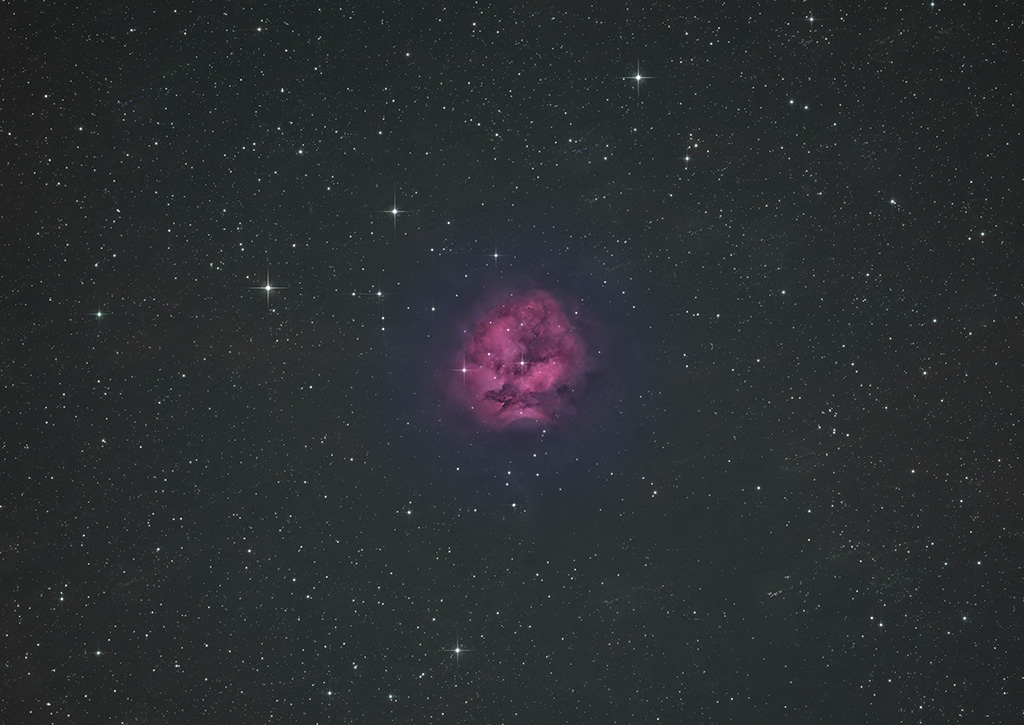
NGC 4565 (also known as the Needle Galaxy or Caldwell 38) is an edge-on spiral galaxy about 30 to 50 million light-years away in the constellation Coma Berenices. It lies close to the North Galactic Pole and has a visual magnitude of approximately 10. It is known as the Needle Galaxy for its narrow profile. First recorded in 1785 by William Herschel, it is a prominent example of an edge-on spiral galaxy. Wikipedia
Imaging Data:
Date: 6/21/2020
Exposure= 60s x 120 of which 64 were used
Binning = 1×1
Camera Temperature= 0 deg C
Camera = ZWO ASI294 MC Pro in Hyperstar Position
Filter= STC Astro Duo-Narrowband Filter
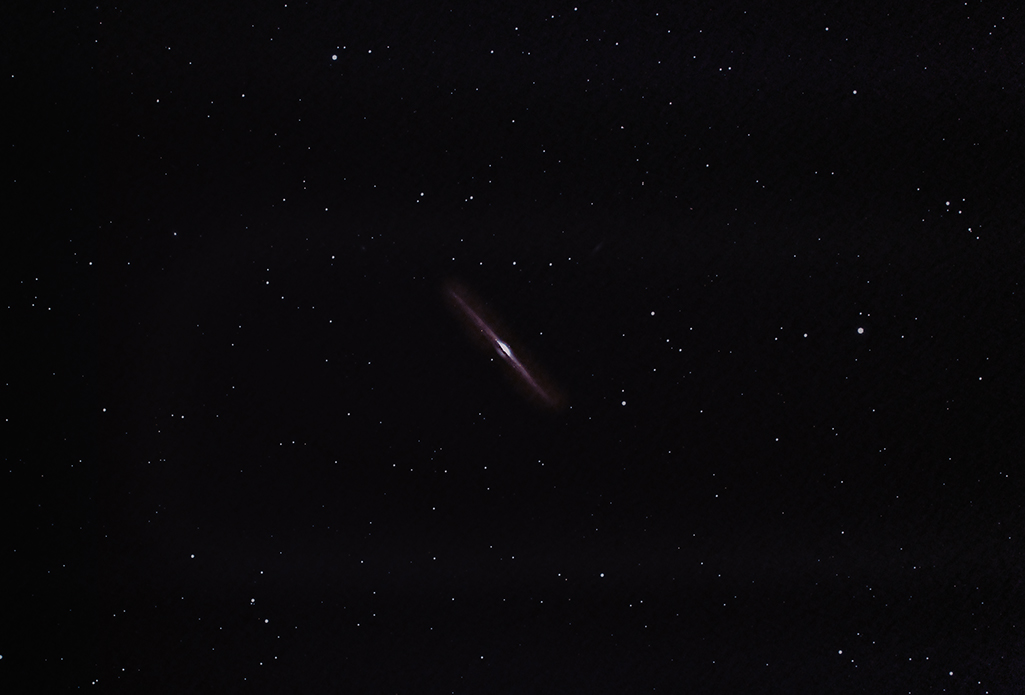
NGC 7635, also known as the Bubble Nebula, Sharpless 162, or Caldwell 11, is an H II region emission nebula in the constellation Cassiopeia. It lies close to the direction of the open cluster Messier 52. The "bubble" is created by the stellar wind from a massive hot, 8.7 magnitude young central star, SAO 20575 (BD+60°2522). The nebula is near a giant molecular cloud which contains the expansion of the bubble nebula while itself being excited by the hot central star, causing it to glow. It was discovered in 1787 by William Herschel.
Imaging Data:
Provo, Utah
Bortle 5 sky
Date: 7/14,15,16/2023
Exposure= 180s X 340 (17h) of which 131 were used for 6h 33m
Binning = 1×1
Camera Temperature= 0 deg C
Camera Gain= 100
Filter= IDAS-NBZ Narrowband Filter
Camera: ASI2600MC PRO in Hyperstar IV configuration.
Telescope: Celestron 1100 Edge HD
Mount: 10Micron GM1000HPS
Processed with DSS, PI and PS
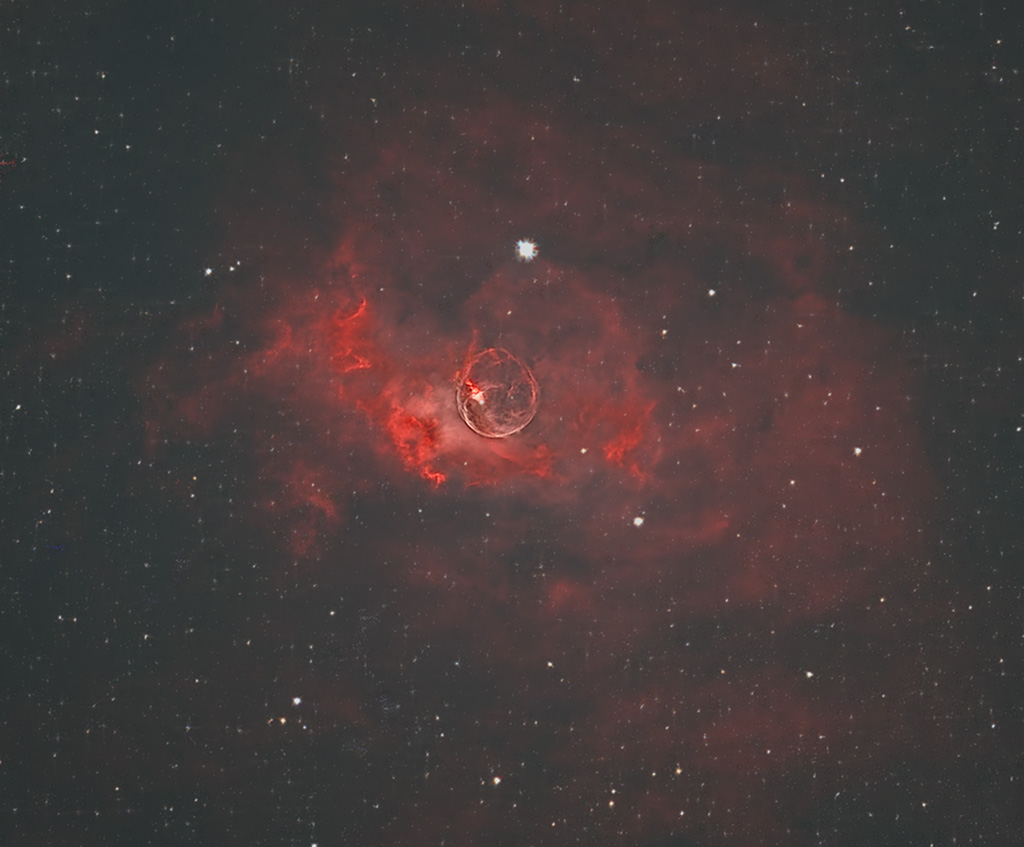
7/21/2020
The North America Nebula is large, covering an area of more than four times the size of the full moon; but its surface brightness is low, so normally it cannot be seen with the unaided eye. Binoculars and telescopes with large fields of view (approximately 3°) will show it as a foggy patch of light under sufficiently dark skies. However, using a UHC filter, which filters out some unwanted wavelengths of light, it can be seen without magnification under dark skies. Its prominent shape and especially its reddish color (from the hydrogen Hα emission line) show up only in photographs of the area.
The portion of the nebula resembling Mexico and Central America is known as the Cygnus Wall. This region exhibits the most concentrated star formation.
The North America Nebula and the nearby Pelican Nebula (IC 5070) are parts of the same interstellar cloud of ionized hydrogen (H II region). Between the Earth and the nebula complex lies a band of interstellar dust that absorbs the light of stars and nebulae behind it, and thereby determines the shape as we see it. The distance of the nebula complex is not precisely known, nor is the star responsible for ionizing the hydrogen so that it emits light. If the star inducing the ionization is Deneb, as some sources say, the nebula complex would be about 1,800 light-years' distance, and its absolute size (6° apparent diameter on the sky) would be 100 light-years.
The nebula was discovered by William Herschel, from Slough, England, on October 24, 1786 or by his son John Herschel before 1833. (Wikipedia)
Imaging Data:
Date: 7/21/20
Exposure= 60s x 316 in a 4 panel mosaic
Binning = 1×1
Gain = 120
Camera Temperature= 0 deg C
Filter= STC Astro Duo-Narrowband Filter
Camera = ASI294MC PRO in Hyperstar position
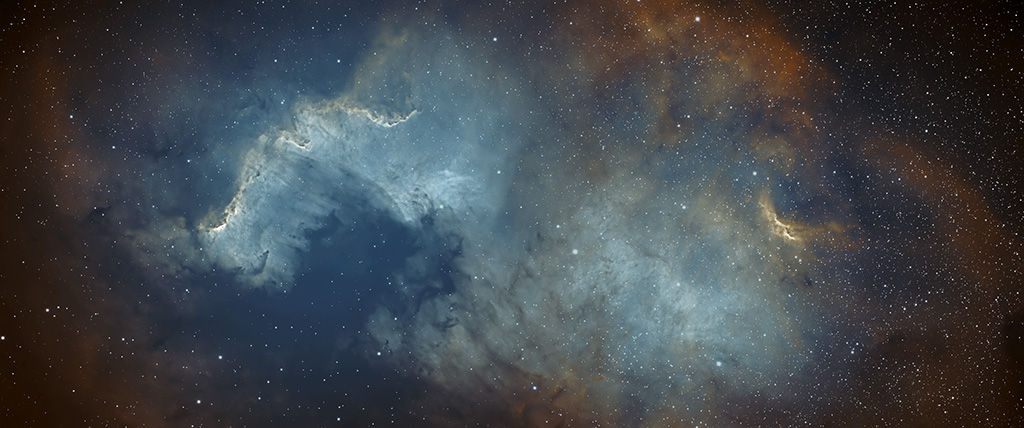
9/26/2021. Here is another image of NGC 7000
Imaging Data:
NGC 7000
Date: 9/25/21
Exposure = 300sx43 (Panel 1) of which 32 were used
300sx60 (Panel 2) of which 29 were used
Binning = 1×1
Gain = 125
Camera Temperature= -10 deg C
Filter : IDAS NEZ Nebula Booster
Camera : ASI294MC PRO in Hyperstar position
Mount : 10Micron GM1000 HPS
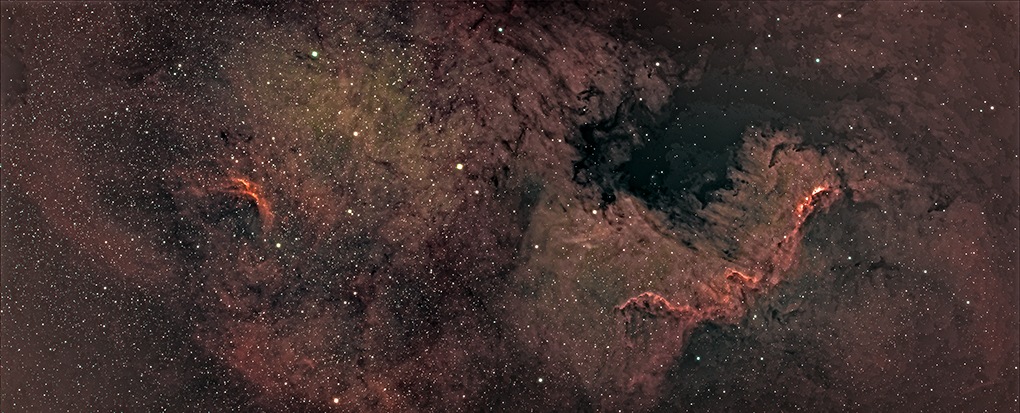
6/19/2021 Last night I imaged IC 5070
THE PELICAN NEBULA
The Pelican Nebula (also known as IC 5070 and IC 5067) is an H II region associated with the North America Nebula in the constellation Cygnus. The gaseous contortions of this emission nebula bear a resemblance to a pelican, giving rise to its name. The Pelican Nebula is located nearby first magnitude star Deneb, and is divided from its more prominent neighbor, the North America Nebula, by a molecular cloud filled with dark dust. It lies about 1800 light years from Earth.
The Pelican is much studied because it has a particularly active mix of star formation and evolving gas clouds. The light from young energetic stars is slowly transforming cold gas to hot and causing an ionization front gradually to advance outward. Particularly dense filaments of cold gas are seen to still remain, and among these are found two jets emitted from the Herbig–Haro object 555. Millions of years from now this nebula might no longer be known as the Pelican, as the balance and placement of stars and gas will leave something that appears completely different.
Imaging Data
Image: IC 5070
Date: 8/242023
Exposure: 180 sec
Number of Lights: 120 of which 81 were used for 4h 3m
Gain: 100
Binning: 1×1
Camera Type: ZWO ASI2600MC Pro using Hyperstar IV.
Cooling Temp: 0 deg C
Filter: IDAS-NBZ Narrowband Filter
Telescope: Celestron 1100HD SCT
Mount : 10MICRON GM1000HPS
Focuser: MicroTouch Focuser
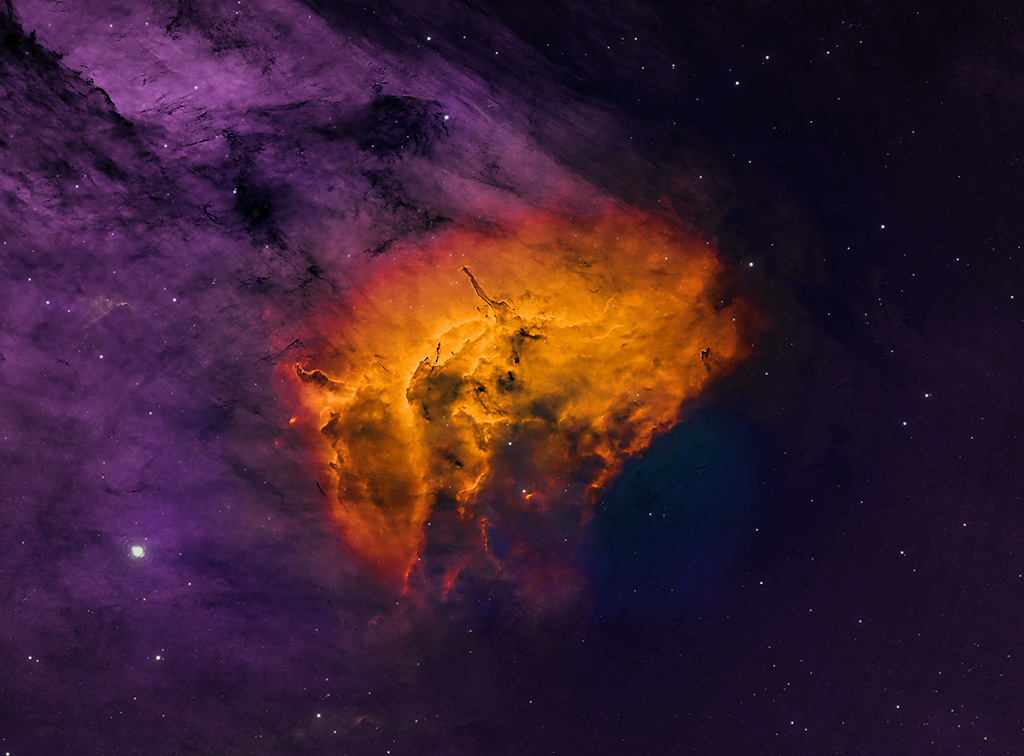
8/16/2020
Commonly known as the Lagoon Nebula, M8 was discovered in 1654 by the Italian astronomer Giovanni Battista Hodierna, who, like Charles Messier, sought to catalog nebulous objects in the night sky so they would not be mistaken for comets. This star-forming cloud of interstellar gas is located in the constellation Sagittarius and its apparent magnitude of 6 makes it faintly visible to the naked eye in dark skies. The best time to observe M8 is during August.
Located 5,200 light-years from Earth, M8 is home to its own star cluster: NGC 6530 (not visible in the image above). The massive stars embedded within the nebula give off enormous amounts of ultraviolet radiation, ionizing the gas and causing it to shine. NASA
Imaging Data
Image: M8
Date: 8/14/2020 reprocessed on 8/5/2024
Exposure: 30 sec
Number of Lights: 148 lights for 1H and 14M of which 105 were used for 52.5 minutes
Gain: 120
Binning: 1×1
Camera Type: ZWO ASI294MC Pro
Cooling Temp: 0 deg C
Filter: STC Astro Duo-Narrowband Filter
Telescope: Celestron 1100HD SCT
Mount : 10MICRON GM1000HPS
Focuser: MicroTouch Focuser
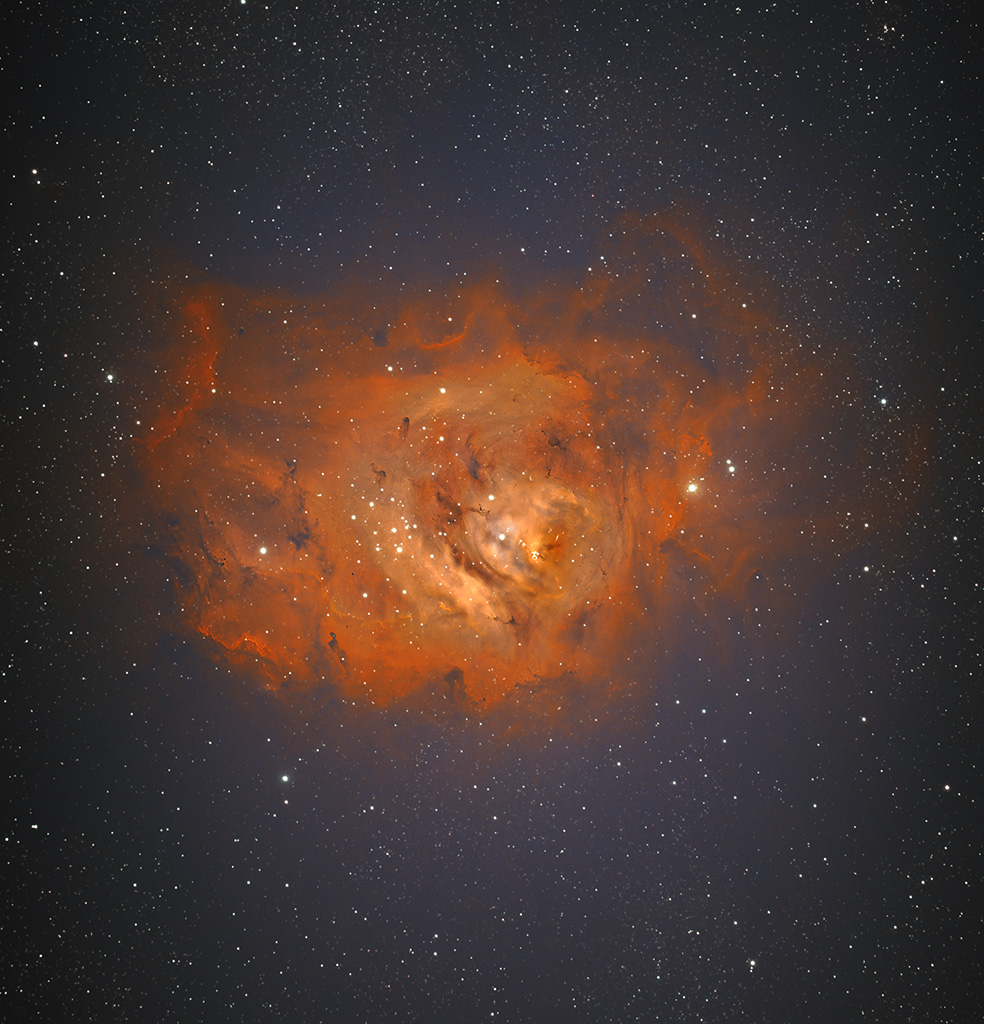
NGC 1977 is an HII region and bright nebulae that includes a reflection nebula located in the constellation Orion. It is the northernmost part of the asterism known as Orion's Sword, lying 0.6° north of the Orion Nebula. The Running Man Nebula is a popular target for amateur astrophotographers, as it lies close to the Orion Nebula and has many nearby guide stars. The outline of the running man shows up primarily in photographs; it is difficult to perceive visually through telescopes, though the reflection nebula itself is visible in small to medium apertures in dark skies. Wikipedia
This reflection nebula, also known as NGC 1977, is located in the constellation of Orion about 1,500 light years from Earth. Space.com
Imaging Data:
Date Nov 29, 2020
Exposure= 10 seconds x 900 for a total exposure of 1 hour 9 minutes 30 seconds of which 41 minutes and 20 seconds were used.
Gain=120
Binning = 1×1
Camera Temperature= -10 deg C
Filter= STC Astro Duo-Narrowband Filter
Camera: ASI294MC PRO in Hyperstar configuration.
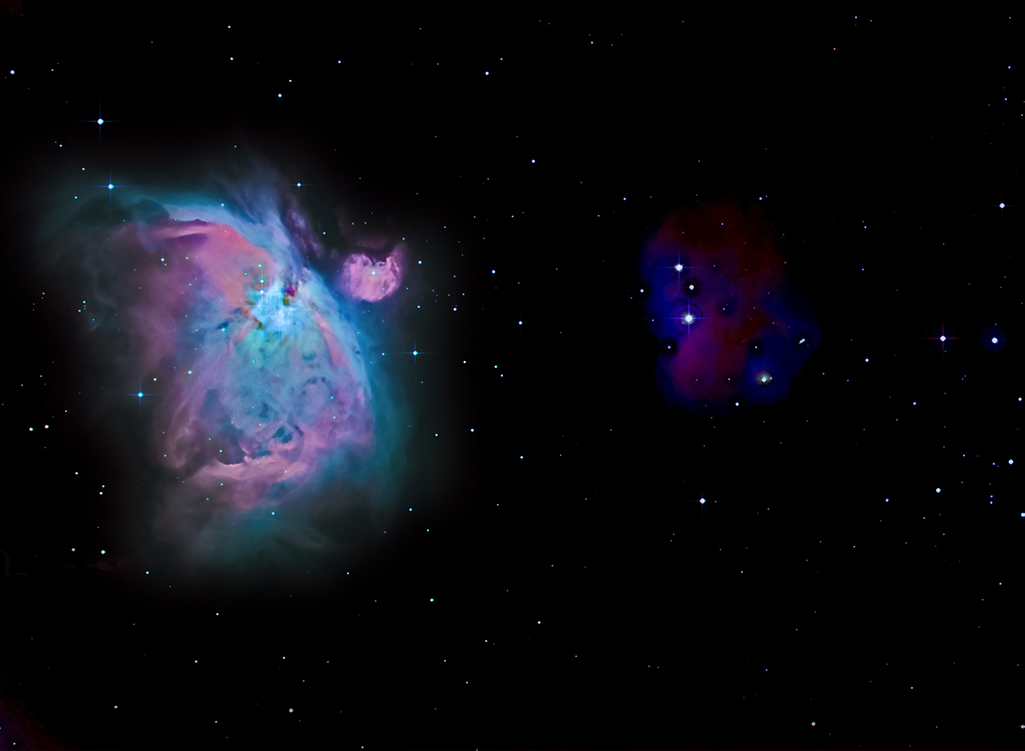
4/10/2021 LEO’S TRIPLET
The Leo Triplet, or the M66 Group, is a group of interacting spiral galaxies located in the northern constellation Leo. The group consists of the galaxies Messier 65, Messier 66 and NGC 3628, also known as the Hamburger Galaxy. The Leo Triplet lies at an approximate distance of 35 million light years from Earth.
The three large spiral galaxies can be seen in a single field of view and are well viewed even in small telescopes. Their galactic disks are tilted at different angles when seen from Earth. NGC 3628 appears edge-on, while M65 and M66 are inclined enough to reveal their spiral arms.
The M66 Group is located in the eastern part of Leo constellation, along the line from the bright star Denebola to Regulus. The galaxies are located between the stars Chertan, Theta Leonis, and Iota Leonis.
Messier 66, the largest and brightest member of the Leo Triplet, is roughly 95 light years across. It has an apparent size of 9.1 by 4.2 minutes of arc and an apparent magnitude of 8.9.
Messier 65 has a visual magnitude of 10.25 and occupies an area of 8.709 by 2.454 arc minutes of apparent sky. It is an intermediate spiral galaxy, poor in dust and gas, and shows little evidence of star formation.
NGC 3628 is an unbarred spiral galaxy with a visual magnitude of 10.2. Seen edge-on, the galaxy occupies an area of 15 by 3.6 arc minutes and appears transected by a broad band of dust that stretches along its outer edge, hiding the young stars in the galaxy’s spiral arms.
The three galaxies in the M66 Group have all been affected by gravitational interactions with each other. This is evident in the deformed, drawn out spiral arms of M66 that are experiencing a high rate of star forming activity and in the warped, inflated disk of NGC 3628. With a prominent tidal tail consisting mainly of young blue stars, NGC 3628 seems to be the most affected of the three, while M65 appears to have suffered the least damage from the interaction. The tidal tail of NGC 3628 spans over 300,000 light years, but is very faint and does not always appear in images of the galaxy. (Messier-Objects.com)
Imaging Data
Image: LEO’S TRIPLET
Date: 4/10/2021
Exposure: 30s
Number of Lights: 600 of which 307 were used for 2 hours, 33 minutes, 30 secomds
Darks: No
Flats: No
Gain: 120
Binning: 1×1
Imaging Software: Sequence Generator Pro
Camera Type: ZWO ASI294MC Pro
Cooling Temp: -10 deg C
Filter: STC Astro Duo-Narrowband Filter
Telescope: Celestron 1100HD SCT
Mount : 10MICRON GM1000HPS
Focuser: MicroTouch Focuser
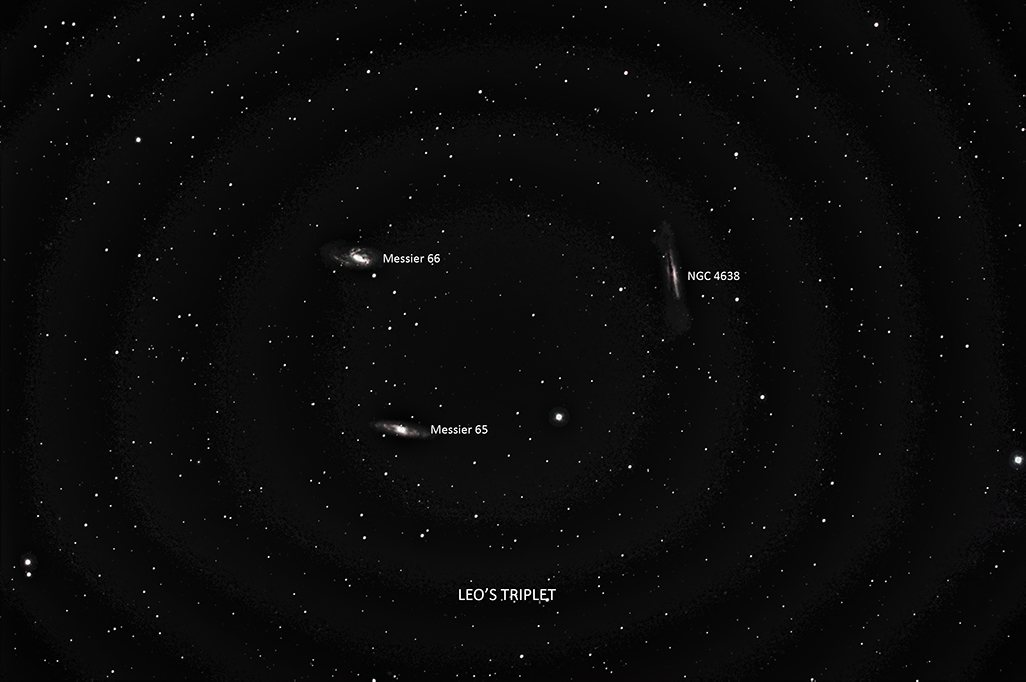
4/18/2021 MARKARIAN’S CHAIN
I imaged this on April18th and is composed of 347 x 30 second images.
Markarian's Chain is a stretch of galaxies that forms part of the Virgo Cluster. When viewed from Earth, the galaxies lie along a smoothly curved line. Charles Messier first discovered two of the galaxies, M84 and M86, in 1781. The other galaxies seen in the chain were discovered by William Herschel and are now known primarily by their catalog numbers in John Louis Emil Dreyer's New General Catalogue, published in 1888. It was ultimately named after the Armenian astrophysicist, Benjamin Markarian, who discovered their common motion in the early 1960s. Member galaxies include M84 (NGC 4374), M86 (NGC 4406), NGC 4477, NGC 4473, NGC 4461, NGC 4458, NGC 4438 and NGC 4435. It is located at RA 12h 27m and Dec +13° 10′.
The bright members of the chain are visible through small telescopes. Larger telescopes can be used to view the fainter galaxies.
At least seven galaxies in the chain appear to move coherently, although others appear to be superposed by chance. Six of the points on the chain can be marked by galaxies. The other two points are pairs of galaxies. Wikipedia
These galaxies lie about 60 million light years away.
Imaging Data
Image: Markarian’s Chain
Date: 4/18/2021
Exposure: 30s
Number of Lights: 346
Darks: No
Flats: No
Gain: 120
Binning: 1×1
Imaging Software: Sequence Generator Pro
Camera Type: ZWO ASI294MC Pro
Cooling Temp: -10 deg C
Filter: Astronomik UV/IR
Telescope: Celestron 1100HD SCT
Mount : 10MICRON GM1000HPS
Focuser: MicroTouch Focuser
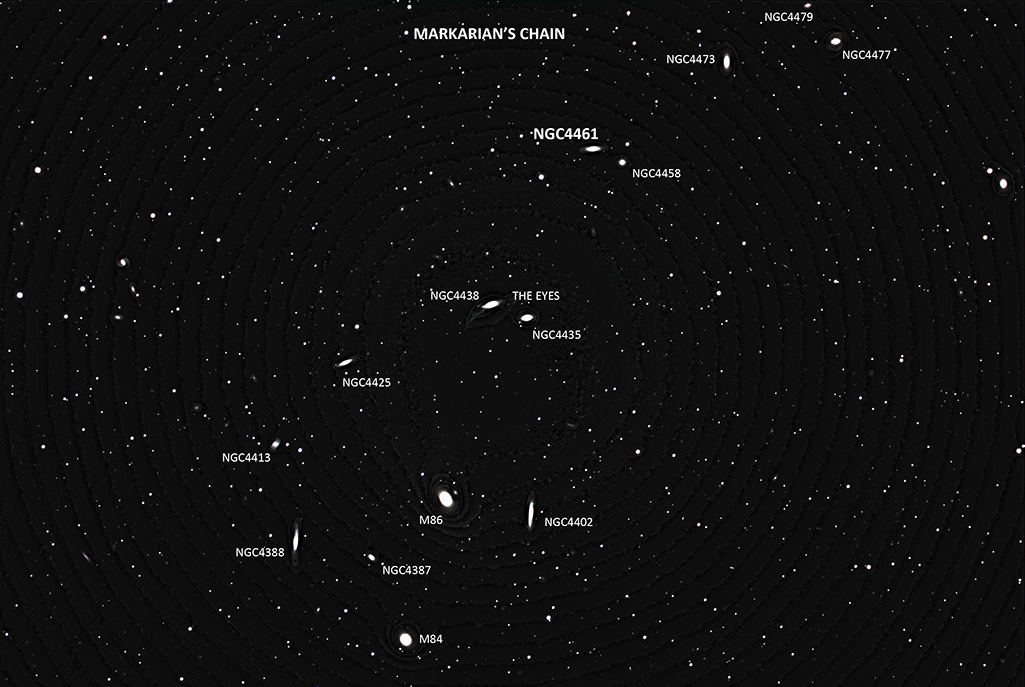
4/26/2012 The Virgo Cluster is a large cluster of galaxies whose center is 53.8 ± 0.3 million light years away in the constellation Virgo. Comprising approximately 1300 (and possibly up to 2000) member galaxies, the cluster forms the heart of the larger Virgo Supercluster, of which the Local Group (containing our Milky Way galaxy) is a member. Wikipedia
Imaging Data
Image: Markarian’s Chain
Date: 4/17/2021
Exposure: 30s
Number of Lights: 198 for 1 hour 39 minutes
Darks: No
Flats: No
Gain: 120
Binning: 1×1
Imaging Software: Sequence Generator Pro
Camera Type: ZWO ASI294MC Pro
Cooling Temp: -10 deg C
Filter: Astronomik UV/IR
Telescope: Celestron 1100HD SCT
Mount : 10MICRON GM1000HPS
Focuser: MicroTouch Focuser
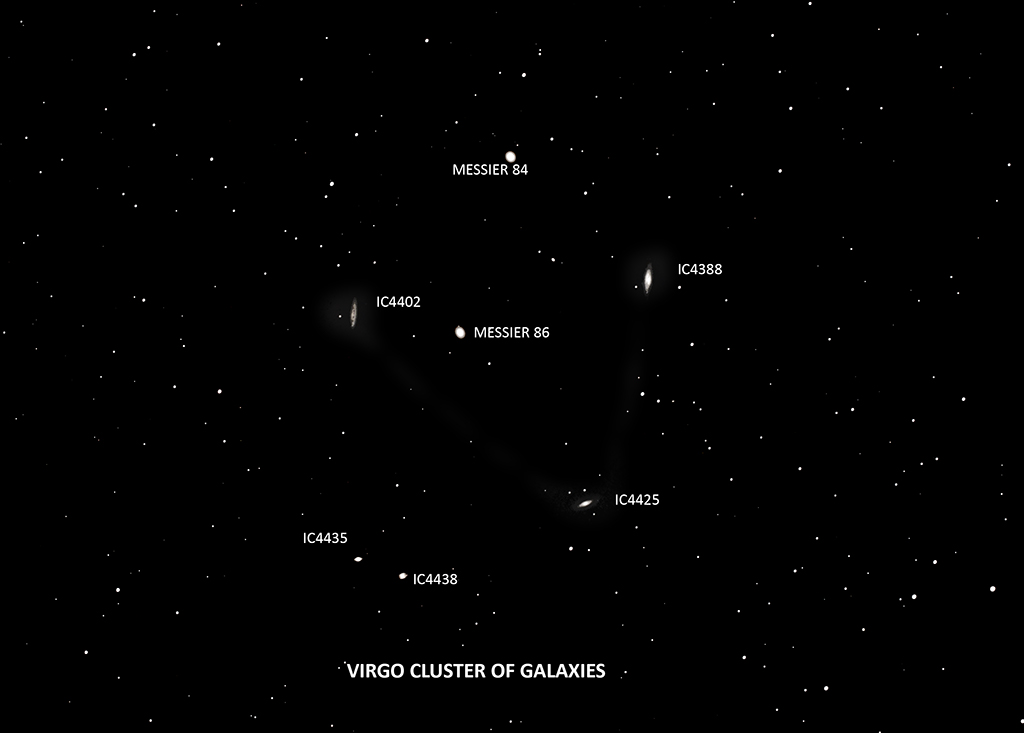
NGC 4631 is a big beautiful spiral galaxy. Seen edge-on, it lies only 25 million light-years away in the well-trained northern constellation Canes Venatici. The galaxy's slightly distorted wedge shape suggests to some a cosmic herring and to others its popular moniker, The Whale Galaxy. Either way, it is similar in size to our own Milky Way. Apod.NASA.gov
Imaging Data:
Date: 3/28/2021
Exposure= 15s & 30s the final time of exposure was 1 hour 27 minutes 30 seconds
Binning = 1×1
Camera Temperature= -10 deg C
Camera Gain= 120
Filter= STC Astro Duo-Narrowband Filter
Camera: ASI294MC PRO in Hyperstar configuration.
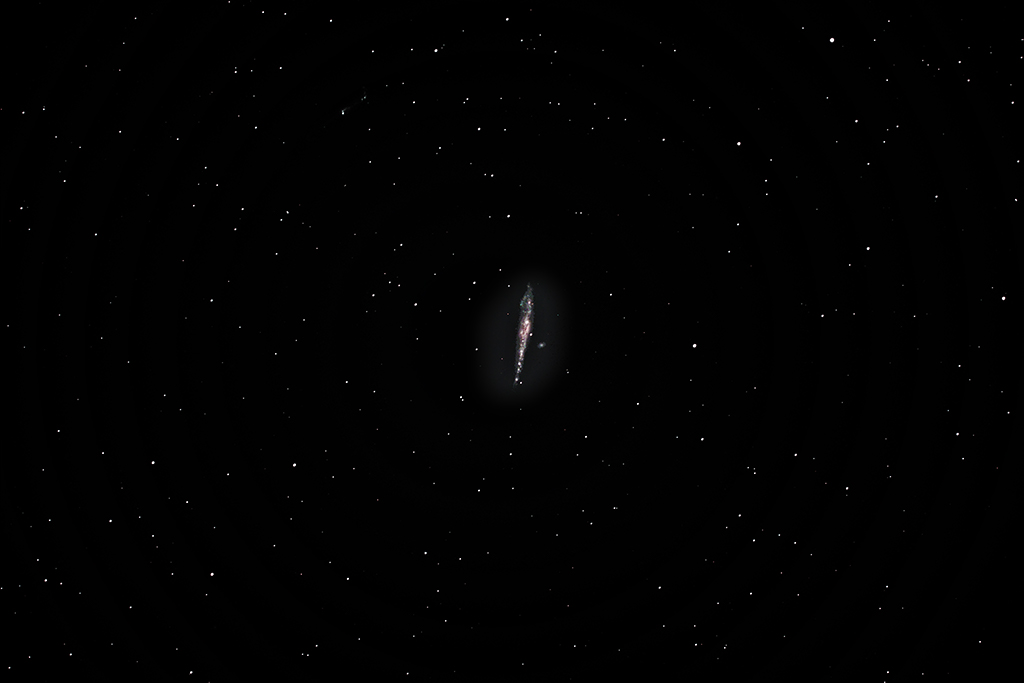
5/27/2021
The Coma Cluster (Abell 1656) is a large cluster of galaxies that contains over 1,000 identified galaxies. Along with the Leo Cluster (Abell 1367), it is one of the two major clusters comprising the Coma Supercluster. It is located in and takes its name from the constellation Coma Berenices.
The cluster's mean distance from Earth is 99 Mpc (321 million light years). Its ten brightest spiral galaxies have apparent magnitudes of 12–14 that are observable with amateur telescopes larger than 20 cm. The central region is dominated by two supergiant elliptical galaxies: NGC 4874 and NGC 4889. The cluster is within a few degrees of the north galactic pole on the sky. Most of the galaxies that inhabit the central portion of the Coma Cluster are ellipticals. Both dwarf and giant ellipticals are found in abundance in the Coma Cluster. Wikipedia
Imaging Data
Image: ABELL 1656
Date: 5/26/2021
Exposure: 300s
Number of Lights: 40 for 3 hours 20 minutes
Darks: No
Flats: No
Gain: 120
Binning: 1×1
Imaging Software: Sequence Generator Pro
Camera Type: ZWO ASI294MC Pro
Cooling Temp: -10 deg C
Filter: STC Astro Duo-Narrowband Filter
Telescope: Celestron 1100HD SCT
Mount : 10MICRON GM1000HPS
Focuser: MicroTouch Focuser
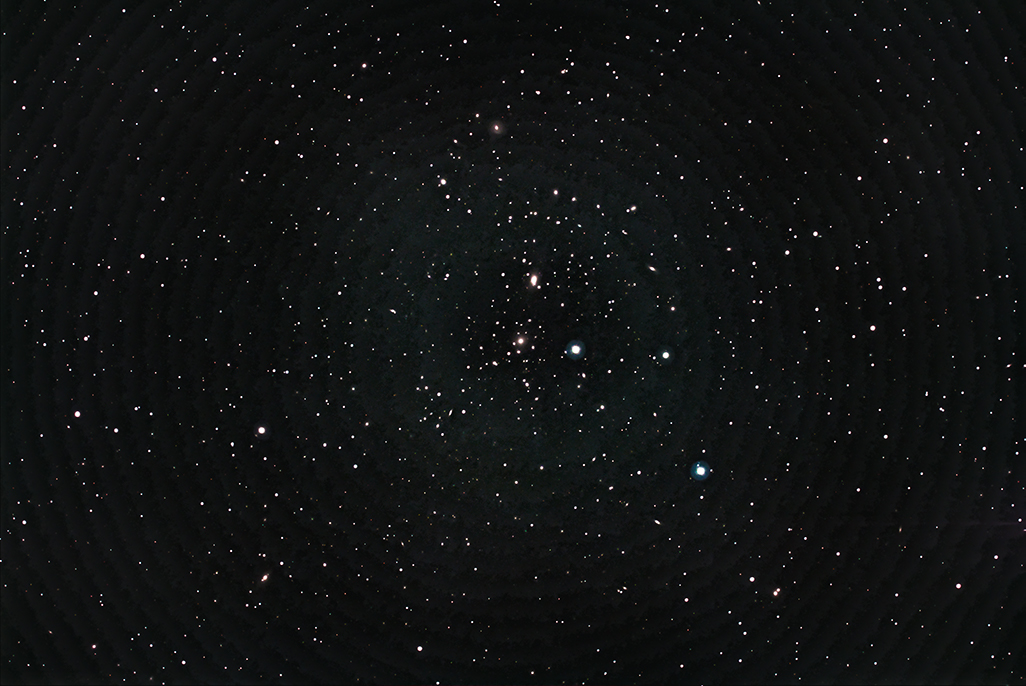
6/3/2021
NGC 6992 is the eastern half of the Veil Nebula, a supernova remnant in Cygnus. Its catalog designations are NGC 6992, NGC 6995 and IC 1340. This bright portion of the Veil Nebula is also known as the Network Nebula. The supernova explosion that created the Veil Nebula occurred 5,000 to 10,000 years ago. It is located 1,400 to 2,500 light-years away in the constellation of Cygnus. Hansonastronomy.com
Imaging Data
Image: NGC 6992
Date: 6/25,26,30/2023
Exposure: 180s
Number of Lights: 202 for 10 hours 6 minutes of which 27 lights totaling 1 hour 27 minutes were used
Darks: No
Flats: No
Gain: 100
Binning: 1×1
Imaging Software: Sequence Generator Pro
Camera Type: ZWO ASI2600MC Pro
Cooling Temp: 0 deg C
Filter: IDAS-NBZ Narrowband Filter
Telescope: Celestron 1100HD SCT
Mount : 10MICRON GM1000HPS
Focuser: MicroTouch Focuser
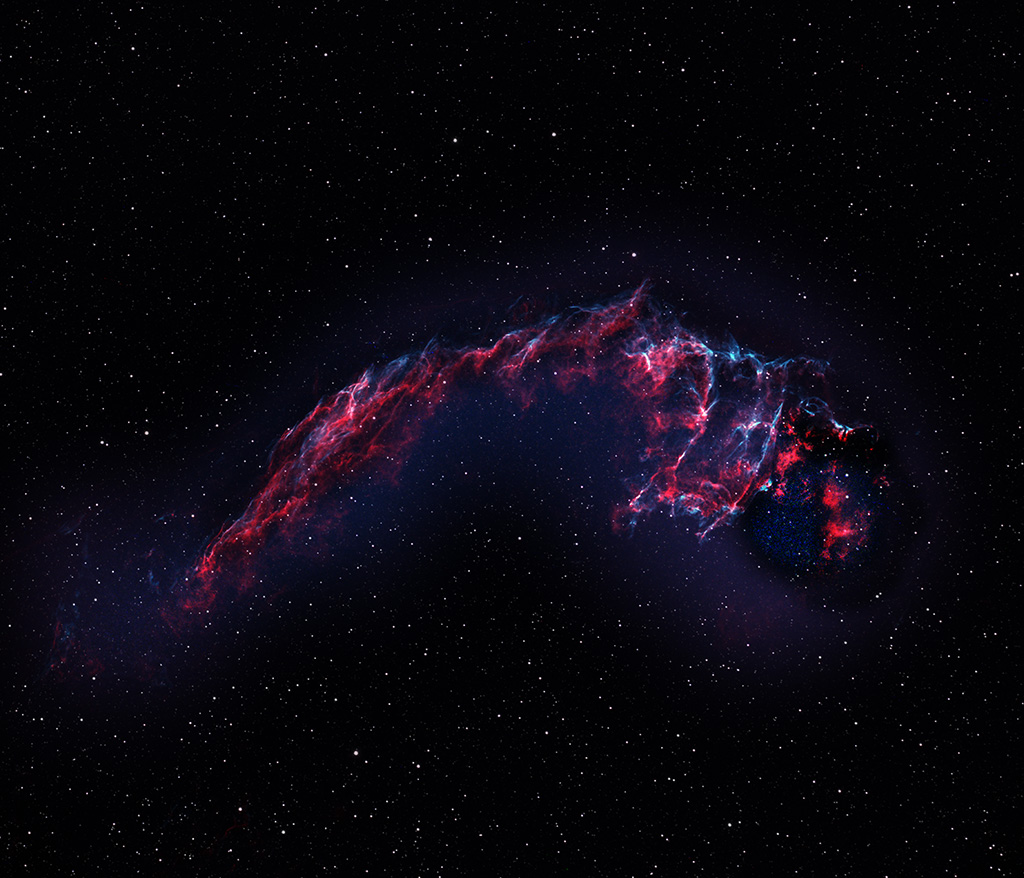
6/4/2021
IC 1318
In the constellation of the swan near the nebula of the pelican lies the gas cloud of the butterfly next to a star known as the hen. That star is given the proper name Sadr, but the central Butterfly Nebula is designated IC 1318. The intricate patterns in the bright gas and dark dust are caused by complex interactions between interstellar winds, radiation pressures, magnetic fields, and gravity. The portion of the Butterfly Nebula pictured spans about 100 light years and lies about 4000 light years away.
Imaging Data
Image: IC 1318
Date: 6/4/2021
Exposure: 300s
Number of Lights: 59 of which 51 were used for a total of 55 minutes
Darks: Yes
Flats: No
Gain: 120
Binning: 1×1
Imaging Software: Sequence Generator Pro
Camera Type: ZWO ASI294MC Pro
Cooling Temp: -10 deg C
Filter: STC Astro Duo-Narrowband Filter
Telescope: Celestron 1100HD SCT
Mount : 10MICRON GM1000HPS
Focuser: MicroTouch Focuser
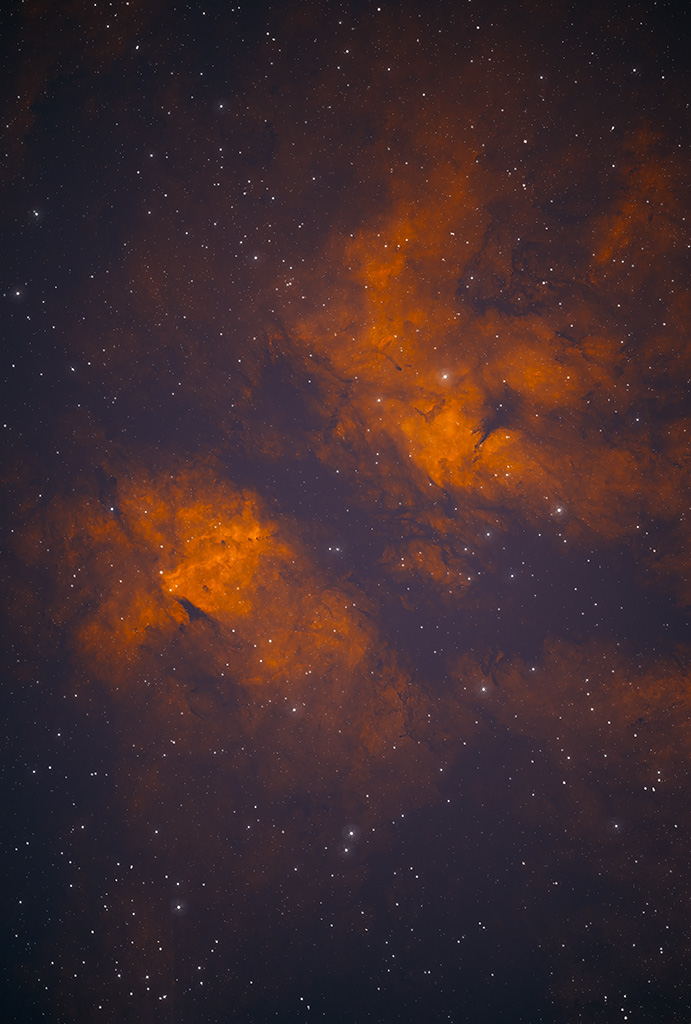
2/12/2022
The Horsehead Nebula is the dark nebula in front of the bright red emission nebula IC 434. Dark Nebulae are clouds of dust in space that obscure the stars behind them. Emission nebulae are clouds of glowing ionized gas. Reflection nebulae do not shine by their own light, but are visible because they reflect the light of nearby stars. Along with the Orion Nebula, M42, it is part of a very large complex that is a stellar nursery where stars are forming out of the dust and gas. Located about 1,500 light years away, this complex is the closest star forming region to our own solar system. The Flame Nebula, NGC 2024, is to the lower left of Alnitak, Zeta Orionis, the easternmost star in the three distinctive stars in the Hunter's belt of Orion, and the brightest star in this photo. To the lower left of the Horsehead is the blue reflection nebula NGC 2023. Other reflection nebulae in the photo are IC 435, IC 432 and IC 431. Jwinman.com
Imaging Data:
Date: 2/9/2022
Exposure: 180 seconds x 60 of which 35 images were used for 2h 15m
Binning: 1×1
Gain: 100
Camera Temperature: -10 deg C
Filter: STC Astro Duo-Narrowband Filter
Camera: ASI2600MC PRO in Hyperstar position
Mount : 10Micron GM1000HPS on pier
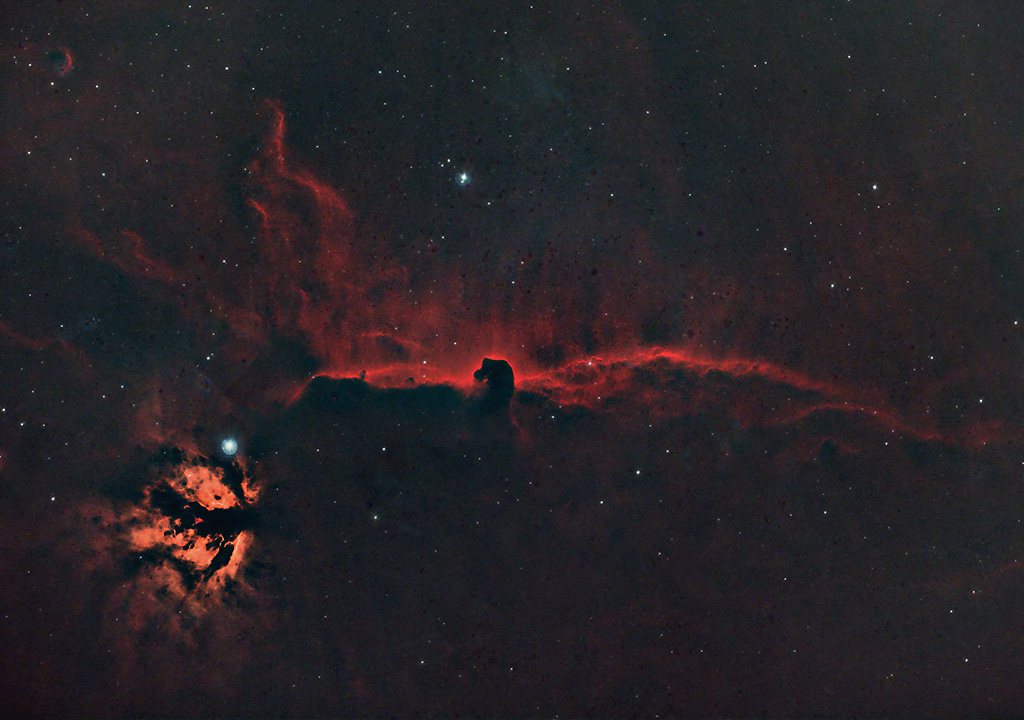
2/22/2022
IC 443 (also known as the Jellyfish Nebula and Sharpless 248 (Sh2-248)) is a galactic supernova remnant (SNR) in the constellation Gemini. On the plane of the sky, it is located near the star Eta Geminorum. Its distance is roughly 5,000 light years from Earth.
IC 443 may be the remains of a supernova that occurred 3,000 – 30,000 years ago. The same supernova event likely created the neutron star CXOU J061705.3+222127, the collapsed remnant of the stellar core. IC 443 is one of the best-studied cases of supernova remnants interacting with surrounding molecular clouds. Wikipedia
IMAGING DATA
Provo, Utah
Bortle 5 sky
Date: 2/14&18/2022 11/16/2023
Image: IC 443
Size: 50’
Camera: ZWO ASI2600 MC Pro in Hyperstar Position
Filter: STC Astro Duo-Narrowband
Temperature: 0 deg C
Gain: 100
Binning: 1×1
Exposure: 180 seconds
# of Lights: 224 for 12 hours 0 minutes were used.
Telescope: Celestron 1100 Edge HD
Hyperstar IV Camera mount
Mount: 10Micron GM1000HPS
Pier: Steel pier on 600 lb concrete block
Observatory: NexDome “Y Mountain Observatory”
Software used
Deep Sky Stacker, Pixinsight, Photoshop
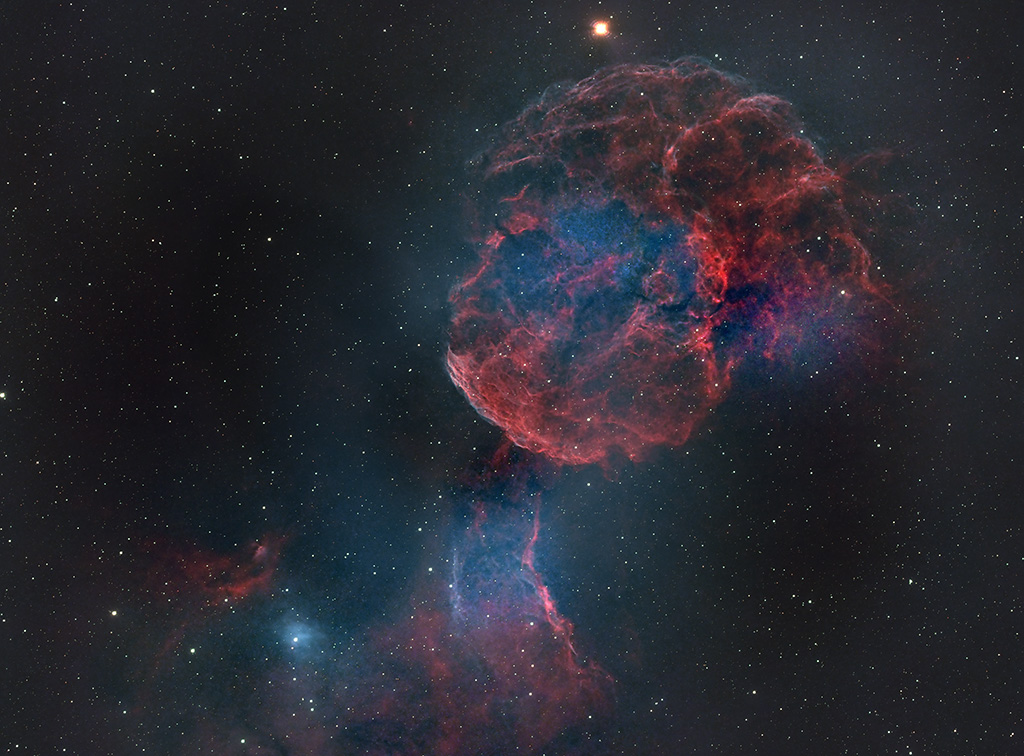
The Wizard Nebula
NGC 7380 (also known as the Wizard Nebula) is an open cluster discovered by Caroline Herschel in 1787. William Herschel included his sister's discovery in his catalog, and labeled it H VIII.77. It is also known as 142 in the 1959 Sharpless catalog (Sh2-142). This reasonably large nebula is located in Cepheus. It is extremely difficult to observe visually, usually requiring very dark skies and an O-III filter.
Located 7200 light years away, the Wizard nebula, surrounds developing open star cluster NGC 7380. Visually, the interplay of stars, gas, and dust has created a shape that appears to some like a fictional medieval sorcerer. The active star-forming region spans about 100 light years, making it appear larger than the angular extent of the Moon. The Wizard Nebula can be located with a small telescope toward the constellation of the King of Aethiopia (Cepheus). Although the nebula may last only a few million years, some of the stars being formed may outlive our Sun.
Imaging Data
Image: NGC 7380
Date: 7/2/2023
Exposure: 180s
Number of Lights: 97 of which 15 were used for 45 min
Darks: No
Flats: No
Gain: 100
Binning: 1×1
Imaging Software: Sequence Generator Pro
Camera Type: ZWO ASI2600MC Pro
Cooling Temp: 0 deg C
Filter: IDAS-NBZ Duo-Narrowband
Telescope: Celestron 1100HD SCT
Mount: 10MICRON GM1000HPS
Focuser: MicroTouch Focuser
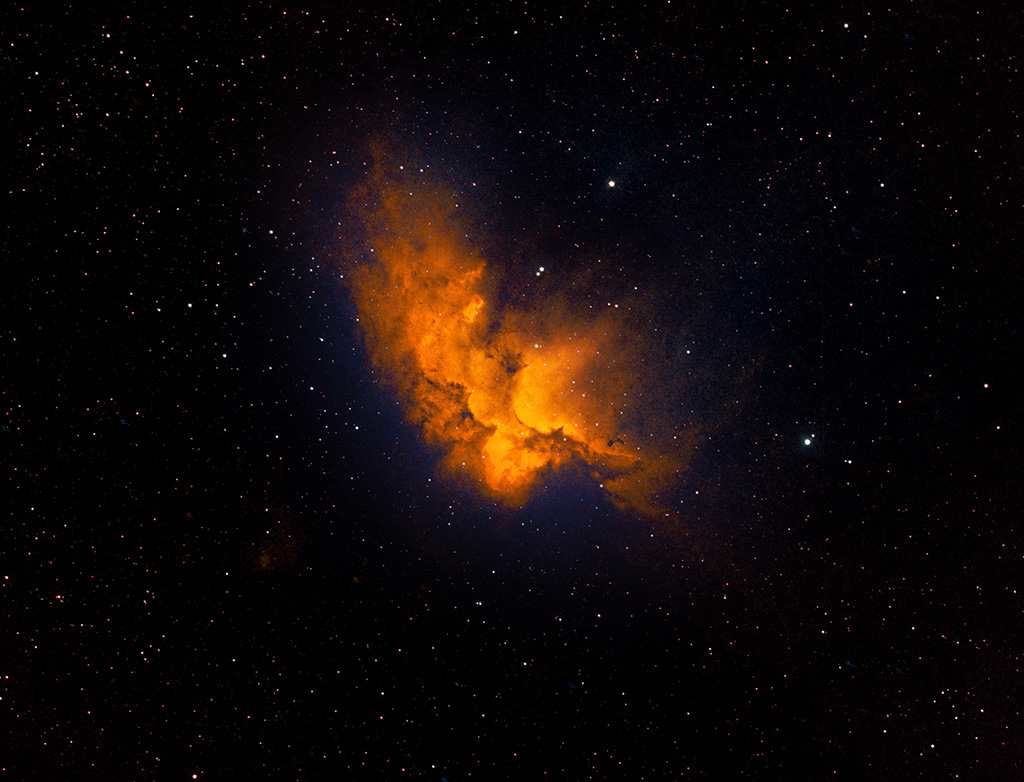
6/19/2023
Discovered in 1702 by the German astronomer Gottfried Kirch, M5 is one of the oldest globular clusters in the Milky Way galaxy. With an apparent magnitude of 6.7 and a location 25,000 light-years away in the constellation Serpens, M5 appears as a patch of light with a pair of binoculars and is best viewed during July.
A majority of M5’s stars formed more than 12 billion years ago, but there are some unexpected newcomers on the scene, adding some vitality to this aging population.
Stars in globular clusters are believed to form in the same stellar nursery and grow old together. The most massive stars age quickly, exhausting their fuel supply in less than a million years, and end their lives in spectacular supernova explosions. This process should have left the ancient cluster M5 with only old, low-mass stars.
Yet astronomers have spotted many young, blue stars amongst the ancient stars in this cluster. Astronomers think that these laggard youngsters, called blue stragglers, were created either by collisions between stars or other stellar interactions. Such events are easy to imagine in densely populated globular clusters, in which up to a few million stars are tightly packed together.
NASA
IMAGING DATA
Date 6/15&16/2023
Exposure 240 sec
No. of lights 110 of which 40 were used for 2 hours 40 minutes
Gain 100
Binning 1×1
Temp 0 deg C
Camera ZWO AMI2600MC Pro using Hyperstar IV
Filter IDAS-NBZ Nebula Boost Filter
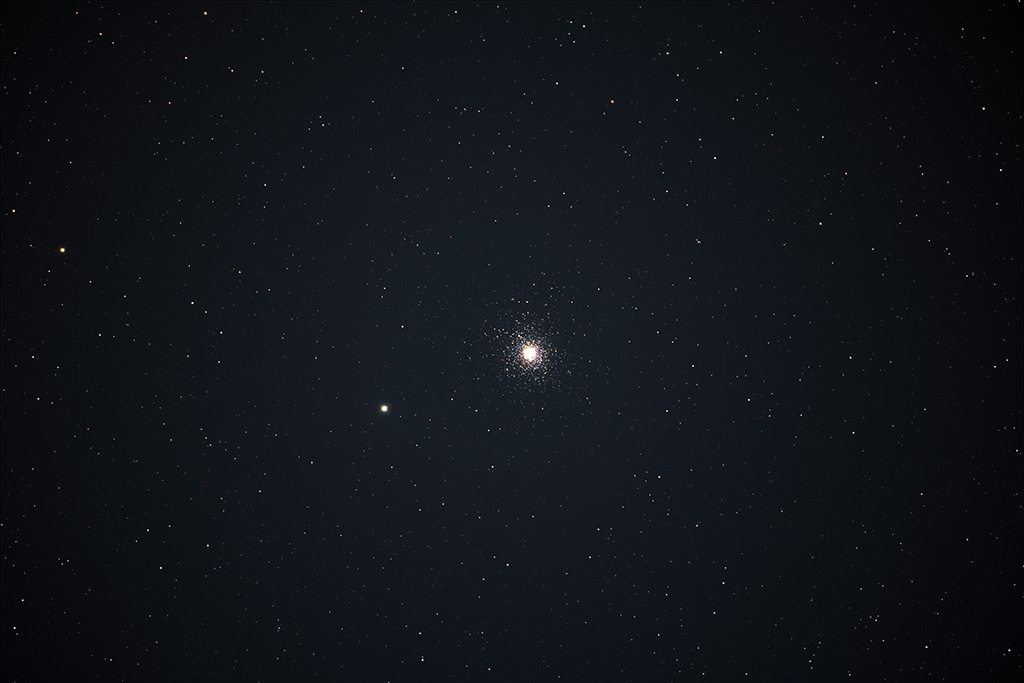
7/4/2023
The Cat's Eye Nebula (also known as NGC 6543 and Caldwell 6) is a planetary nebula in the northern constellation of Draco, discovered by William Herschel on February 15, 1786. It was the first planetary nebula whose spectrum was investigated by the English amateur astronomer William Huggins, demonstrating that planetary nebulae were gaseous and not stellar in nature. Structurally, the object has had high-resolution images by the Hubble Space Telescope revealing knots, jets, bubbles and complex arcs, being illuminated by the central hot planetary nebula nucleus (PNN). It is a well-studied object that has been observed from radio to X-ray wavelengths.
Surface temperature for the central PNN is about 80000 K, being 10000 times as luminous as the sun. The Cat's Eye Nebula, given in some sources, lies about three thousand light-years from Earth. Wikipedia
Imaging Data:
Date: 5/29/2020
Exposure= 60s x 350 of which 220 where used
Binning = 1×1
Gain = 120
Camera Temperature= 0 deg C
Filter= STC Astro Duo-Narrowband Filter
Camera = ASI294MC PRO in Hyperstar position

7/14/2023
NGC 6820 is a small reflection nebula near the open cluster NGC 6823 in Vulpecula. The reflection nebula and cluster are embedded in a large faint emission nebula called Sh 2-86. The whole area of nebulosity is often referred to as NGC 6820.
Open star cluster NGC 6823 is about 50 light-years across and lies about 6,000 light-years away. The center of the cluster formed about two million years ago and is dominated in brightness by a host of bright young blue stars. Outer parts of the cluster contain even younger stars. It forms the core of the Vulpecula OB1 stellar association. Wikipedia
Imaging Data
Provo, Utah
Bortle 5 sky
Image: NGC 6820
Date: JULY 8, 10, 12, 13, 2023
Exposure: 180 sec
Number of Lights: 455 of which 80 were used for 6 HOURS
Gain: 100
Binning: 1×1
Camera Type: ZWO ASI2600MC Pro
Cooling Temp: 0 dec C
Filter: IDAS-NBZ Narrowband Filter
Telescope: Celestron 1100HD SCT
Mount : 10MICRON GM1000HPS
Focuser: MicroTouch Focuser
Processed with DSS, PI and PS
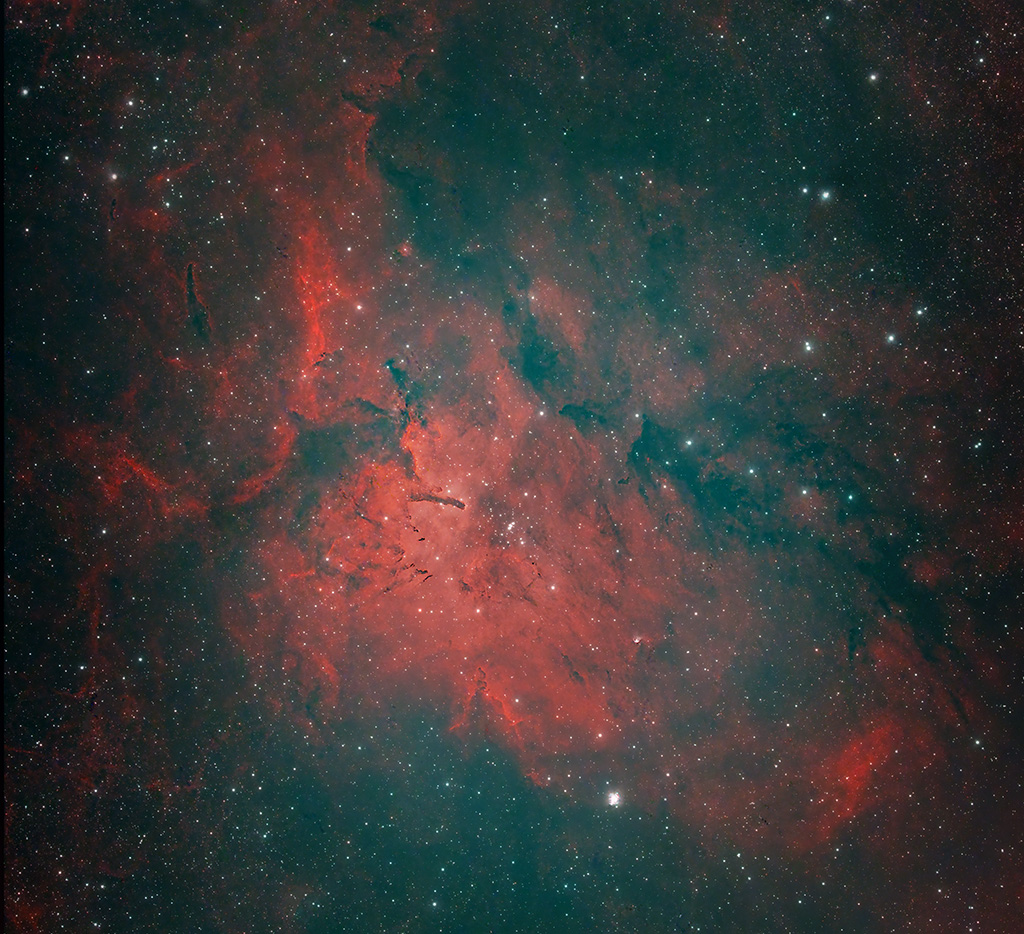
7/18/2023 I just added this old image.
NGC 2174 (also known as Monkey Head Nebula) is an H II[1] emission nebula located in the constellation Orion and is associated with the open star cluster NGC 2175. It is thought to be located about 6,400 light-years away from Earth. The nebula may have formed through hierarchical collapse.
Glowing gas and dark dust do not survive well in the Monkey Head Nebula. Young stars near the center of the nebula generate stellar winds and high energy radiation that causes the nebula's material to shift into complex shapes. The nebula is primarily composed of hydrogen which glows at infrared wavelengths due to the radiation. Wikipedia
Imaging Data:
Provo, Utah
Bortle 5 sky
Date : Feb 25, 2022
Exposure : 300s x 19 for 1h 40m from which I used 13 images for 1h 5m
Gain=100
Binning = 2×2
Camera Temperature= -10 deg C
Filter= IDAS NBZ Narrow band filter
Camera: ASI2600MC PRO in Hyperstar IV configuration.
Telescope: Celestron 1100 Edge HD
Mount: 10Micron GM1000HPS

8/6/2023
NGC 7331, also known as Caldwell 30, is an unbarred spiral galaxy about 40 million light-years away in the constellation Pegasus. It was discovered by William Herschel in 1784. Wikipedia
Imaging Data:
Provo, Utah
Bortle 5 sky
Date: 8/4/2023
Image: NGC 7331
Size:=10.2’
Magnitude=9.5
Exposure= 180 seconds x 120 of which 57 were used for a total of 2h 51m
Binning = 1×1
Camera Temperature= 0 deg C
Camera Gain= 100
Filter= IDAS-NBZ Narrowband Filter
Camera: ASI2600MC PRO in Hyperstar IV configuration.
Telescope: Celestron 1100 Edge HD
Mount: 10Micron GM1000HPS
Processed with DSS, PI and PS
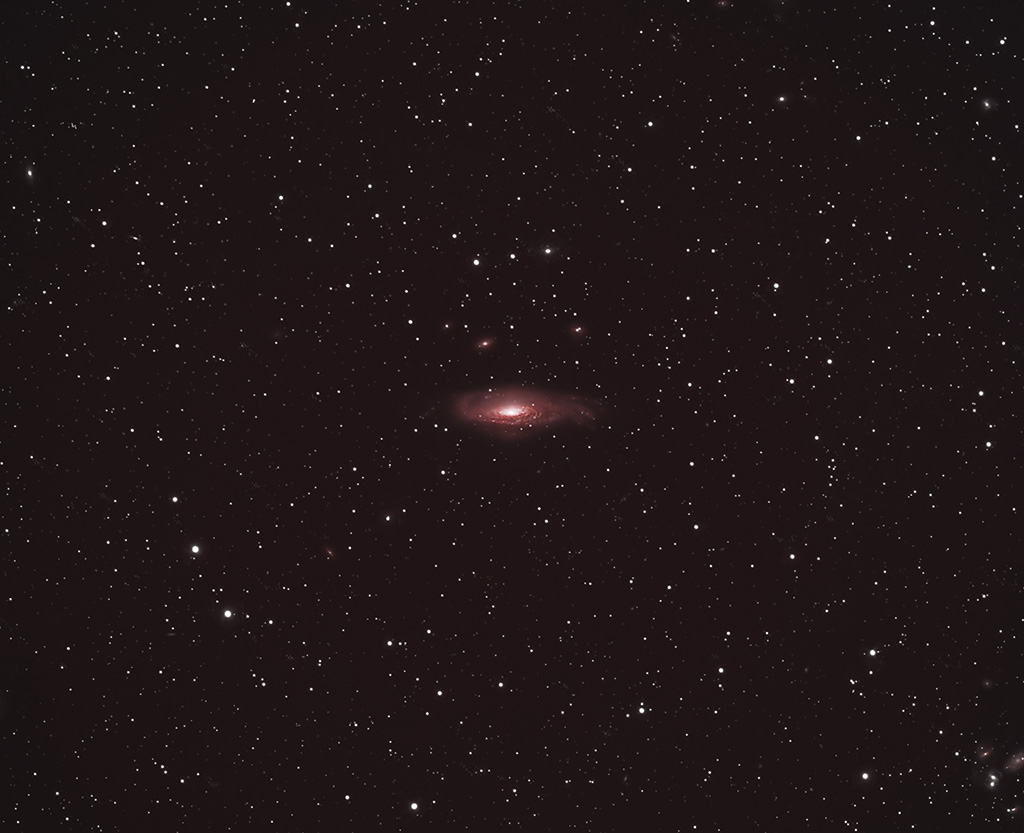
Go to PAGE 2



